

mailto: payer@payer.de
Zitierweise / cite as:
Payer, Margarete <1942 - >: Kulturen von Arbeit und Kapital. -- Teil 3: Kapitaleignerkulturen. -- 7. Postsowjetische Oligarchen. -- 1. Russland (Россия). -- 1. Firmen. -- Fassung vom 2005-12-17. -- URL: http://www.payer.de/arbeitkapital/arbeitkapital0307011.htm
Erstmals publiziert: 2005-12-17
Überarbeitungen:
Anlass: Lehrveranstaltung an der Hochschule der Medien Stuttgart, Wintersemester 2005/06
Copyright: Dieser Text steht der Allgemeinheit zur Verfügung. Eine Verwertung in Publikationen, die über übliche Zitate hinausgeht, bedarf der ausdrücklichen Genehmigung des Verfassers.

Diese Inhalt ist unter einer Creative Commons-Lizenz lizenziert.
Dieser Text ist Teil der Abteilung Länder und Kulturen von Tüpfli's Global Village Library
![]()
Klicken Sie hier für "Wirtschaft Russland" in den Schlagzeilen
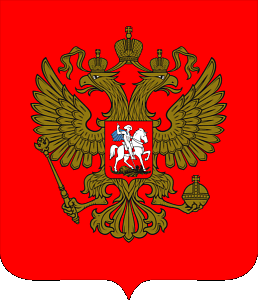
Russische Föderation
Российская Федерация
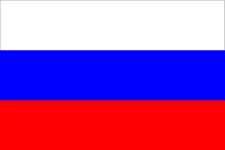
Die Firmen sind nach ihren Hauptgeschäftsbereichen angeordnet.
Die folgende Zusammenstellung strebt keine Vollständigkeit an, sondern ist nur eine - vielleicht nicht einmal repräsentative - Auswahl.
Zu den im Folgenden genannten Personen siehe:
Payer, Margarete <1942 - >: Kulturen von Arbeit und Kapital. -- Teil 3: Kapitaleignerkulturen. -- 7. Postsowjetische Oligarchen. -- 2. Russland (Россия). -- 2. Personen. -- URL: http://www.payer.de/arbeitkapital/arbeitkapital0307012.htm
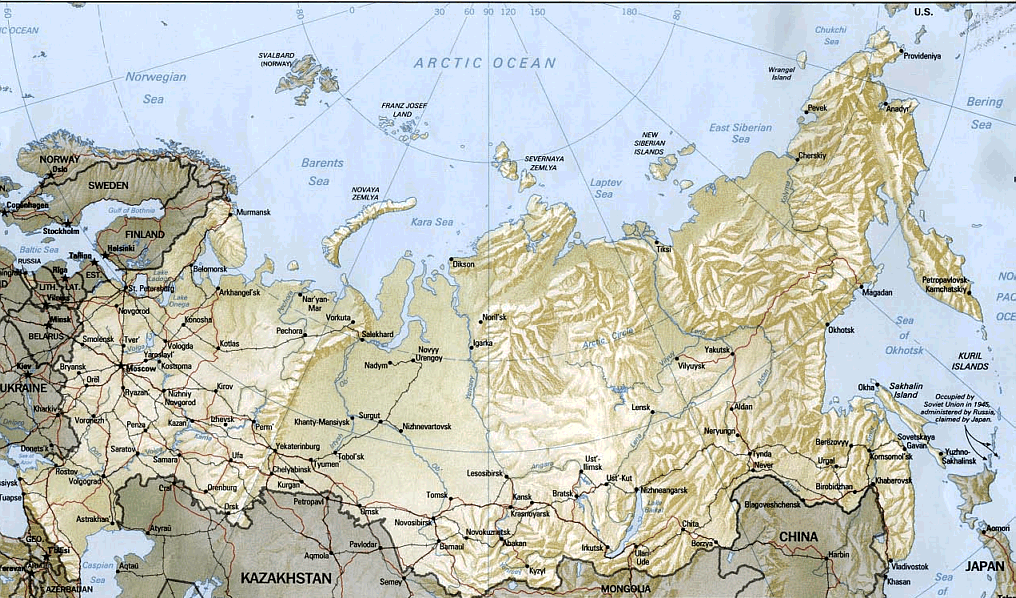
Abb.: Russland
(Bildquelle. CIA)
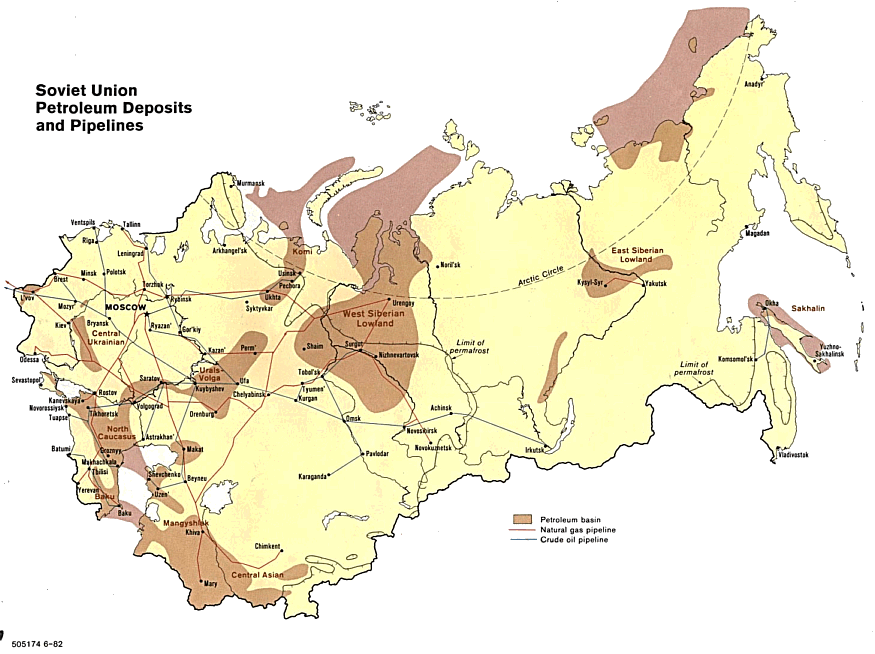
Abb.: Erdöllager in der Sowjetunion, 1982
[Bildquelle. CIA]
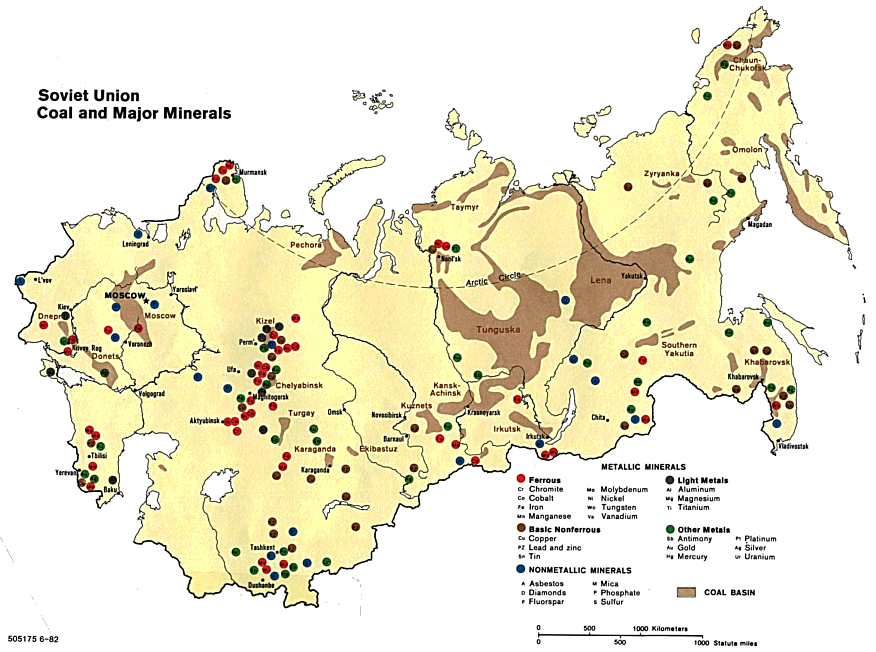
Abb.: Minerallagerstätten in der Sowjetunion, 1982
[Bildquelle: CIA]
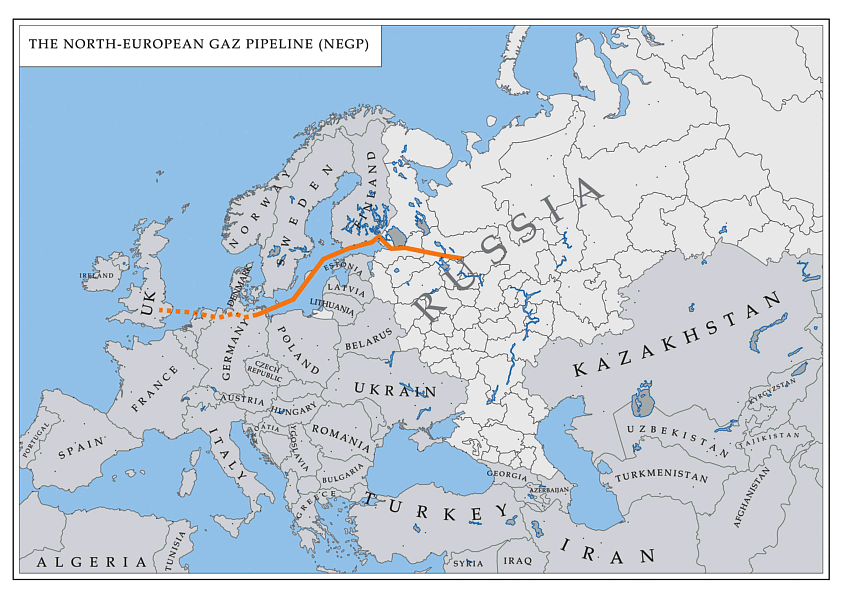
Abb.: Gasproms geplante North-European Gaz Pipeline (NEGP)
[Gasprom Pressebild]
Webpräsenz: http://www.gazprom.ru/eng/. -- Zugriff am 2005-12-03]
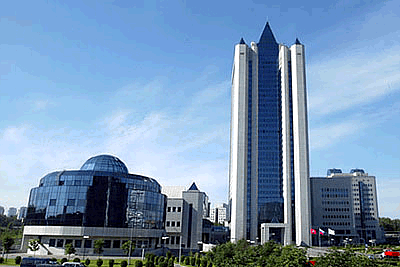
Abb.. Gasprom-Hauptsitz, Moskau
(Pressefoto Gasprom)
"Gazprom (Cyrillic Газпром, sometimes transcribed as Gasprom) is the largest Russian company and the biggest natural gas extractor in the world. Gazprom supplies almost all the gas needs of Central Europe, Eastern Europe, and the former Soviet Union. With sales of US$ 31 billion in 2004, it accounts for about 93% of Russian natural gas production and with reserves of 17,800 km³, it controls 25% of the world's gas reserves. After the projected acquisition of the oil company Sibneft, Gazprom, with 119 billion barrels of reserves, would rank behind only Saudi Arabia, with 263 billion barrels, and Iran, with 133 billion barrels, as the world's biggest owner of oil and oil equivalent in natural gas.
History1989-1992: Inception
Due to large natural gas reserves discovered in Siberia [Сиби́рь], in the Urals [Урал] and in the Volga [Во́лга] region in the 1970s and 1980s, the Soviet Union became a major gas producer. Gas exploration, development, and distribution were centralized in a state ministry. In July of 1989, President Mikhail Gorbachev [Михаи́л Серге́евич Горбачёв]combined the ministries for oil and gas as part of his economic reforms, and later carved out Gazprom as the entity responsible for gas production, distribution, and sales. Viktor Chernomyrdin [Ви́ктор Степа́нович Черномы́рдин] headed Gazprom.
Abb.: Viktor Chernomyrdin — Виктор Степанович Черномырдин
[Bildvorlage: http://www.nato.int/docu/review/1997/9702-3.htm. -- Zugriff am 2005-12-05]After the break-up of the Soviet Union in 1991, Gazprom lost a large part of its assets outside of Russia - one third of its pipelines and one fourth of its compression capacity.
1993-1997: PrivatizationAfter the new Russian President Boris Yeltsin [Борис Николаевич Ельцин] appointed Chernomyrdin to be his Prime Minister in December 1992, the political influence of Gazprom increased markedly.
As the new government was committed to economic reform, Gazprom began to be privatized, becoming a joint-stock company in November 1992, and starting to distribute shares under the voucher method, where every Russian citizen received vouchers to purchase shares of formerly state-owned companies. However, trading these shares was heavily regulated and the by-laws of the company prohibited foreigners to own more than 9% of the shares.
Gazprom slowly established credibility in the western capital markets with an offering of 1% of its equity to foreigners in October 1996 in the form of London Depository Receipts and a successful large bond issue of US$ 2.5 billion in 1997.
1998-2000: ScandalsIn 1998 Chernomyrdin was fired from his position of Russia's Prime Minister by President Boris Yeltsin. At the same time, the Russian government suddenly started demanding billions of dollars in back taxes from Gazprom. When tax prosecutors started to seize assets of Gazprom, the company gave in and paid. The company's records started showing a loss for the first time. The reasons are unclear and were explained either by an aging pipeline transport network, by a management that was becoming increasingly corrupt, or by pre-existing losses that appeared because of more transparent accounting policies.
Abb.: ®LogoGazprom conducted dubious transactions with Florida-based gas-trading company Itera and a Gazprom/Itera joint-venture, Purgaz, in the late 1990s, which allegedly benefited various management members and their relatives. Additionally, large-scale asset-stripping of Gazprom was going on by corrupt management and board members through various transactions involving the Gazprom daughter Stroitansgaz and the regional gas company Sibneftegaz. The Gazprom auditor PwC apparently had signed off and covered these transactions.
The investment fund Hermitage Capital Management, a minority shareholder of Gazprom, reported on the scandals in October 2000: "Investors are valuing this company as if 99 percent of its assets have been stolen. The real figure is around 10 percent so that's good news".
2001-2003: Reform yearsRussian President Vladimir Putin [Влади́мир Влади́мирович Пу́тин] was actively pursuing reforms in the management of the company in the years following the scandals. This was aided by shareholder activism by Hermitage CEO William Bowder and former Russian finance minister Boris Fyodorov.
Current StructureUntil 2004 the Russian government held a 38.37% stake in the company, and had a majority on the company’s board of directors. Gazprom provides 25% of all Russian tax revenues (averaging over US$ 4 billion annually between 1993-2003) and accounts for 8% of the nation’s gross domestic product. Non-Russian investors may legally buy Gazprom shares only through American Depositary Shares, which cost more than locally traded shares.
In 2004, President Putin announced that Gazprom is acquiring the state-owned oil-company Rosneft [Роснефть] and that this will "eventually lead to the lifting of foreign ownership restrictions on Gazprom shares", as the stake of the Russian government in Gazprom will rise from 38.37% to a contolling position.
However, Gazprom was foiled both in its attempt to acquire Rosneft, and its earlier attempt to buy the core asset of Yukos [ЮКОС], when Yukos filed for bankruptcy in Houston. Fearing that it would fall foul of US law, Gazprom backed away from buying Yukos' main asset when the Russian government auctioned it in December 2004, leaving the more gung-ho Rosneft to buy it. After Rosneft had appropriated such a large and controversial asset, the technicalities of merging it into Gazprom became too complicated. Instead, Rosneft remained independent, to the delight of its own management. The state increased its stake in Gazprom to over 50% instead by paying cash for a 10.4% stake, thus fulfilling the main pre-condition for the abolition of restrictions on foreign ownership of Gazprom shares. At the time of writing, the market is still awaiting this move.
In September 2005, Gazprom bought 72.633% of the oil company Sibneft [Сибне́фть] (siehe unten!) for $13.01 billion, aided by a $12 billion loan from the west, which consolidates Gazprom's position as a global energy giant and Russia's biggest company. On the day of the deal the company was worth £69.7 billion/US$123.2 billion, about the GDP of Ireland in 2004."
[Quelle: http://en.wikipedia.org/wiki/Gazprom. -- Zugriff am 2003-12-03]
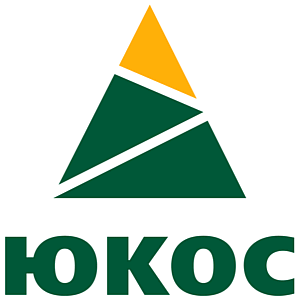
Abb.: ®Logo
Webpräsenz: http://www.yukos.com/. -- Zugriff am 2005-12-03
"Yukos Oil and Gas Company Major holdings: proven oil reserves — 13.734 billion barrels, proven gas reserves — 7.771 trillion cubic feet
Stock Information: Yukos implemented Level 1 ADR program in 2001. Its ADRs are traded over-the-counter in the USA and on the following international platforms: Frankfurt, Munich, Stuttgart and Berlin Stock Exchanges, London Stock Exchange International Order Book. Yukos ticker stock symbols are YUKOY.PK, YUSA and YUK. Yukos is a fully-integrated oil and gas company with headquarters in Moscow, Russia. It is one of the world’s largest private oil companies by reserves and market capitalization. Yukos is an open joint-stock corporation publicly traded on stock exchanges both in Russia and abroad.
The company is involved in just about every aspect of the oil industry, from the well head to the filling station, and is now seeking to become a large gas producer as well. Yukos’ principal production assets are located in the Khanty-Mansiysk Autonomous District and Tomsk Region of Western Siberia and the Samara Region along the Volga River in European Russia. Recent acquisitions have expanded the company’s reach into Eastern Siberia and the Yamal Nenetsk Autonomous District in Russia’s Far North.
Yukos has five principal refineries in Russia, ranging geographically from the Samara Region in the west to Angarsk near Lake Baikal in Eastern Siberia, as well as being the majority owner and operator of the largest refinery in the Baltic States, in Mazeikiai, Lithuania. Yukos also runs eighteen distribution companies and more than 1,200 filling stations under the Yukos brand name. The company currently employs about 100,000 people.
Until recently Yukos oil company was chaired by Mikhail Khodorkovsky, one of the wonder boys of Russian capitalism, who together with a group of colleagues is said to own 40 to 60 percent of Yukos’ shares. However, Khodorkovsky was arrested in October 2003 on charges of tax fraud and is currently standing trial while remaining in detention. After his arrest, Khodorkovsky resigned and was replaced by Simon Kukes as Yukos’ CEO. Yukos has been subject to relentless government scrutiny since 2003.Updated: 05.12.2005 16:55 MSK"
[Quelle: http://mosnews.com/mn-files/yukos.shtml#news. -- Zugriff am 2005-12-06]
"JUKOS (russisch ЮКОС) ist einer der großen Konzerne Russlands für Erdölförderung und Petrochemie und gehört auch weltweit zu den größten nicht-staatlichen Konzernen. Der Name JUKOS ist eine Abkürzung der Firmen, die an der Gründung des Erdölkonzerns beteiligt waren, „JUganskneftegas“ und „KuibyschewnefteOrgSintesa“ (Юганскнефтегаз, КуйбышевнефтеОргСинтеза).
Das Unternehmen
Abb.: Regionale Produktionsgesellschaften von Yukos
[Bildquelle: http://www.yukos.com/EP/General_overview.asp. --- Zugriff am 2005-12-11]Jukos wurde in den letzten Jahren von Michail Chodorkowski [Михаил Борисович Ходорковский] geleitet, einem politisch und sozial engagierten Milliardär, und hatte bis zu dessen Verhaftung im Oktober 2003 den zweiten Platz am Markt inne.
Durch diesen Vorgang und restriktive Maßnahmen des Kreml ist der Konzern international bekannt geworden, aber auch in wirtschaftliche Schwierigkeiten geraten. Chodorkowski wurden (wie auch einem zweiten Manager) Steuervergehen vorgeworfen, doch ließ der Prozessbeginn bis Juni 2004 auf sich warten. Als eigentliche Gründe werden vermutet, dass Chodorkowski (der zu Russlands „Oligarchen“ zählt), als Präsidentschaftskandidat vorgeschlagen war, bzw. weil die russische Regierung den Konzern (wie schon früher) in ihren Einflussbereich bringen will. Auch hatte sich Präsident Putin negativ zur Unterstützung von Bildungseinrichtungen und Medien durch Jukos geäußert. Als Grund hierfür gilt, dass die Förderung des politischen Pluralismus sowie der Meinungs- und Medienvielfalt nicht mit allen politischen Bestrebungen Putins in Einklang steht.
Jukos wurde im Zuge der großen Privatisierungswelle nach Auflösung der Sowjetunion unter kontroversen Umständen von der russischen Regierung erworben. Der Erwerb erfolgte im Rahmen einer Versteigerung, welche von der durch Chodorkowski mitgegründeten Bank MENATEP organisiert wurde, die dann selbst als einziger Bieter auftrat. MENATEP war in den Jahren zuvor selbst zu einer finanzkräftigen Privatbank geworden, da Chodorkowski ihr als stellvertretender Öl- und Energieminister unter Boris Jelzin zahlreiche Aufträge zur Verwaltung von Investitionsprogrammen hatte zukommen lassen. Später ging Jukos an eine Gruppe (auch internationaler) Investoren. Hauptanteilseigner wurde Chodorkowski.
Westliche Ökonomen schätzen einerseits die Flexibilität und Ertragskraft des Konzerns, werfen ihm aber auch eine dubiose Politik gegenüber den Kleinaktionären vor. Dies soll sich ab etwa 2001 gebessert haben. In den letzten Jahren konnte Jukos Umsatzsteigerungen von 30 % bis 104 % und Gewinnmargen bis 50 % vorzeigen und wurde zum Börsenmagneten, nicht nur in Russland (2000: 9,8 Mrd. US-Dollar). Er investierte kräftig in den Energiebereich:
- Beteiligung an zahlreichen regionalen Energieunternehmen wie Belgorod, Kuban und Tomskenergo
- Joint Ventures mit TotalFinaElf zur Ausbeutung eines Ölfeldes im Schwarzen Meer und mit der ungarischen MOL (2002)
- Partnersuche für eine bayerische Raffinerie und ein deutsches Tankstellennetz von Shell und BP-Aral, dessen Verkauf das Kartellamt vorschrieb, usw.
- Kauf von 49 % des Erdölleitungsnetz-Betreibers Transpetrol (Slowakei)
- andere Kooperationen
Die tägliche Erdölfördermenge von Jukos beträgt etwa 1,7 Millionen Barrel, was etwa 15 % der gesamten russischen Ölförderung entspricht.
Der „Fall Jukos“Im April 2003 vereinbarte Jukos eine Verschmelzung mit Sibneft [Сибне́фть] (nach dem Umsatz etwa die Nr. 5 in Russland), doch unterblieb die Fusion durch die Nachwirkungen der Verhaftung Chodorkowskis. Ende Oktober 2003 fror die Regierung 44 Prozent der Aktien ein, um ihre Übernahme durch eine mit Chodorkowski kooperierende Investorengruppe zu verhindern.
Seither sinkt die Ertragskraft von Jukos kontinuierlich – was nach den kräftigen Zuwächsen der letzten Jahre umso auffälliger ist. Der Kurs fiel gegenüber dem Jahresmittel (etwa 40 Euro) um bis zu 80 %, was alle russischen Aktienbörsen beeinträchtigte. Anfang 2004 tauchten Gerüchte über Zahlungsunfähigkeit auf – und der Verdacht, dass die Restriktionen einer Insolvenz und einem billigen Kauf durch den Staat dienen würden.
Am 31. Mai 2004 erklärte ein Moskauer Schiedsgericht die für die Zusammenlegung mit Sibneft bestimmte Zusatzemission von Jukos-Papieren für nichtig, wodurch der Konzern das Recht auf 57,5 % der Sibneft-Aktien einbüßt. Im Juni erklärte Gasprom [Газпром], der weltweit größte Erdgasproduzent, im Falle einer Versteigerung Jukos-Aktiva zu erwerben.
Am 29. Juni 2004 wurden die Steuernachzahlungen in Höhe von umgerechnet 2,8 Milliarden Euro für das Jahr 2000 gerichtlich bestätigt und somit rechtskräftig. Gerichtsvollzieher leiteten nach dem Urteil ein Vollstreckungsverfahren ein. Das Unternehmen muss nach deren Beschluss diesen Betrag bis Ende August 2004 begleichen. Die Steuerschuld für 2001 beträgt ebenfalls umgerechnet 2,8 Milliarden Euro. Für 2002 und 2003 werden jeweils Forderungen in etwa gleicher Höhe gestellt. Das Unternehmen bot an, eine Zahlung von einer Milliarde Euro bei Erlass der Restsumme zu leisten. Seitens der Behörden wurde hierauf jedoch nicht eingegangen. Das russische Finanzministerium beharrt weiter auf der Begleichung der gesamten Steuerschuld. Bei einer Zwangsvollstreckung droht Jukos nach eigenen Angaben die Insolvenz. Das Vollstreckungsverfahren wurde inzwischen eingeleitet. Hierbei ist zu bedenken, dass in der Rangordnung der Gläubiger die Steuerbehörden über den Geldgebern sowie den Zulieferern stehen. Somit würde der russische Staat seine Interessen über das Steuerrecht durchsetzen.
Ende Juli 2004 wird in russischen Medien berichtet, ein britisches Konsortium aus privaten Investoren wolle Jukos vor der Pleite retten, indem es die Steuerschuld für Jukos tilge und im Gegenzug Vermögenswerte des Konzerns übernehme. Hinter der Initiative soll unter anderem auch der frühere Jukos-Minderheitsaktionär Konstantin Kagalowski stehen, der an der Privatisierung des Unternehmens beteiligt war. Auf Anweisung der Gerichtsvollzieher mussten die vier Fördergesellschaften von Jukos den Verkauf anderer Vermögenswerte mit sofortiger Wirkung stoppen. Förderung, Verarbeitung und Verkauf von Erdöl können jedoch fortgesetzt werden. Anfang August 2004 wurden die zuvor eingefrorenen Konten des Konzerns für die Finanzierung der Kernoperationen des Unternehmens vom Gerichtsvollzieher zunächst kurzzeitig wieder freigegeben. Dieser Beschluss wurde vom Justizministerium jedoch noch am selben Tage wieder zurückgenommen.
Im November 2004 wurde bekannt, dass am 19. Dezember 2004 die Mehrheit des Hauptunternehmens Juganskneftegas versteigert werden soll, um die Steuerschuld der zurückliegenden Jahre zu begleichen. Auf Juganskneftegas entfallen rund 60 Prozent der gesamten Ölförderung von Jukos. Dieses Unternehmen fördert in Westsibirien täglich eine Million Barrel Rohöl. Dieser Schritt ist nahezu gleichbedeutend mit einer Zerschlagung des Konzerns Jukos.
Am 19. Dezember 2004 wurde dann die wichtigste Tochter des russischen Energiekonzerns Jukos für sieben Milliarden Euro aufgekauft. Jukos-Manager hatten Tage zuvor angekündigt, dass sie den potentiellen Käufer vor internationalen Gerichten verklagen werden. Auch hatten die Jukos-Manager in Houston/Texas Gläubigerschutz nach Chapter 11 beantragt. Bei der Versteigerung setzte sich das bislang völlig unbekannte russische Unternehmen „Baikalfinanzgruppe“ [Байкалфинансгруп] durch und übernahm somit drei Viertel des Kerngeschäfts von Jukos. Im Bieterwettstreit standen sich die „Baikalfinanzgruppe“ und Gasprom gegenüber.
Abb.: ®LogoDrei Tage später erfolgte die vollständige Übernahme der Baikalfinanzgruppe [Байкалфинансгруп] durch den staatlichen russischen Ölkonzern „Rosneft“ [Роснефть]. Somit ist es dem russischen Staat gelungen, Jukos aufzuspalten und die Kontrolle über den größten Bestandteil des Unternehmens zu übernehmen.
StimmenDer Anwalt des ehemaligen Mehrheitsaktionärs des russischen Ölkonzerns Jukos, Robert R. Amsterdam, hat nach der Versteigerung von Juganskneftegas Bundeskanzler Gerhard Schröder als „Mafioso“ bezeichnet, da er im Interesse deutscher Konzerne zusammen mit der Deutschen Bank den Rechtsbruch in Russland toleriere.
Zahlreiche Bundestagsabgeordnete, darunter die ehemalige deutsche Justizministerin Sabine Leutheusser-Schnarrenberger, wiesen darauf hin, dass Jukos durch eine Regierung zerschlagen worden sei, die bereit sei, jedes in ihrer Macht stehende Instrument zu nutzen, um ihre Interessen durchzusetzen.
Am 28. Dezember 2004 erklärte der russische Präsidentenberater Andrei Illarionow auf einer Pressekonferenz, beim Fall Jukos habe es sich um die „Affäre des Jahres 2004“ gehandelt.
GeheimdienstspekulationenSeit Anfang 2005 berichtet die Online-Zeitung „Saar-Echo“ über die Hintergründe der Jukos-Affäre. Sie verfolgt die – von den mündlichen Aussagen des ehemaligen BND-Mitarbeiters Ernest Backes gestützte – These, dass amerikanische Interessengruppen der russischen Justiz über Michail Chodorkowski Informationen über Geldwäscheaktivitäten zuspielten. Diese Informationen entstammten einem von Ernest Backes und seinem Mitarbeiter André Strebel erstellten BND-Dossier, das an russische Behörden übergeben worden sein soll. Backes und Strebel waren über Jukos informiert, weil sie im gleichen Zeitraum gegen Chodorkowski und andere Menatep-Manager in der Schweiz Anzeige erstattet hatten. Ziel der von den USA eingefädelten Aktion sei es laut Saar-Echo gewesen, den Jukos-Chef zu stürzen und so selbst Einfluss auf den größten eurasischen Erdölproduzenten erhalten. Die Serie wurde von kleinen Internetmedien weltweit aufgegriffen, erreichte jedoch nirgends meinungsführende Blätter. Im Vorfeld hatte das französische Geheimdienstblatt Intelligence Online über das angebliche BND-Dossier berichtet, aber auch dieser Bericht wurde sonst nicht aufgegriffen.
Laut Saar-Echo habe der BND nach Erhalt des von Backes und Strebel erstellten Jukos-Dossiers, das über den BND und das Bundeskanzleramt auf den Schreibtisch Putins lanciert worden sei, den beiden ehemaligen Bankern in Saarbrücken eine Firma finanziert (IWR – Institut für Wirtschaftsrecherchen GmbH), die fortan als Tarnfirma des deutschen Auslandsgeheimdienstes betrieben wurde. Über die IWR hatten Backes und Strebel anschließend auch die Strafanzeigen in der Schweiz erstattet, die – ohne dass es für die dortige Bundesanwaltschaft erkennbar gewesen wäre – damit faktisch eine Strafanzeige des BND war.
Backes hatte seine Tätigkeit für den BND zugegeben, nachdem der deutsche Auslandsgeheimdienst im Herbst 2004 die Finanzierung der IWR plötzlich eingestellt und damit die BND-Tarnfirma abgeschaltet hatte.
Literatur
- Heiko Pleines und Hans-Henning Schröder (Herausgeber): Die Jukos-Affäre - Russlands Energiewirtschaft und die Politik; Arbeitspapiere und Materialien Nr. 64 der Forschungsstelle Osteuropa an der Universität Bremen, Juni 2005, zweite, aktualisierte Auflage; ISSN 1616-7384; 4 Euro + Porto
- Angela Rustemeyer: Putins Oligarchenfeldzug und Russlands Demokratie; die JUKOS-Affäre und ihr Umfeld in den Augen der politisch liberalen Opposition und der Bevölkerung, Friedrich-Ebert-Stiftung, 2004,ISBN 3-89892-319-3
[Quelle: http://de.wikipedia.org/wiki/Jukos. -- Zugriff am 2005-12-03]
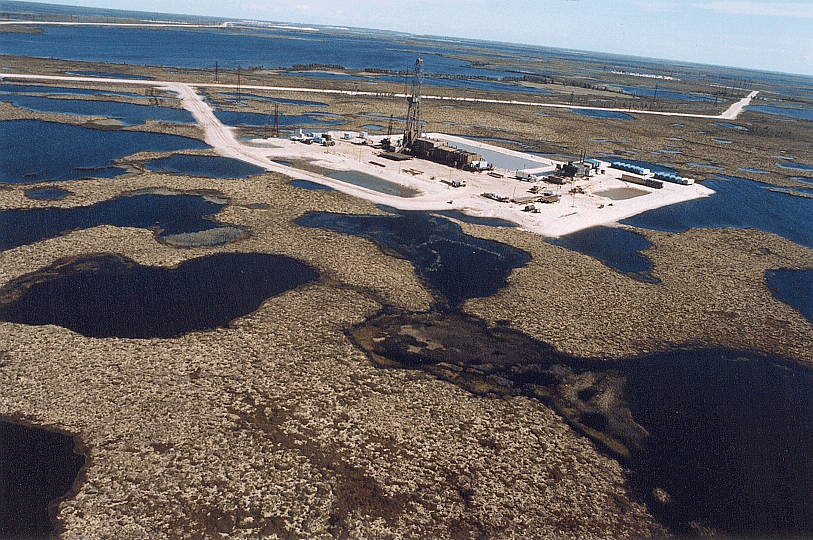
Abb.: Bohrturm in Sibirien
[Bildquelle:
http://www.sibneft.ru/gallery.php?page=47&lang=1. -- Zugriff am 2005-12-03]
Webpräsenz: http://www.sibneft.ru/index-eng.php. -- Zugriff am 2005-12-03
"Sibneft Oil Company
Major holdings: proved oil reserves (2002 estimate) — 4,575 million barrels, proved natural gas reserves (2002 estimate) — 860 billion barrels
Stock Information: Sibneft ADR stock symbol is SIBN. The Sibneft (Siberian oil) company dates back to 1981, when the Soviet exploration activities led to the discovery that, apart from natural gas, commercial reserves of oil lay in West Siberia.
Originally only 49 percent of Sibneft shares were sold off to outside investors, and the federal government kept 51 percent of the equity. However, in December of 1995, the government put its stake in Sibneft under trust management as part of the notorious Loans for Shares program which was masterminded byVladimir Potanin . Under the scheme, private investors extended loans to the state in exchange for the right to manage the state’s holding in a number of companies. Later, these shares were to be sold at a special auction to private investors.
The Sibneft oil company came under control ofRoman Abramovich , a young entrepreneur who in 1992 was befriended by Boris Berezovsky, then one of Russia’s most powerful oligarchs. Abramovich, who controls all of the assets of his business empire through Millhouse Capital, a British-registered investment fund, owns an 80 percent stake in Sibneft.
The first attempt to merge Sibneft with Mikhail Khodorkovsky’sYukos Oil Company came in 1998. The staffs of the two companies even moved into the same building, and a new name, YukSi, was proposed. However, later the deal was called off. The second attempt came in 2003, and the market analysts supposed that this time the merger was going to be more successful. The creation of YukosSibneft was announced on October 3, 2004. However, after the arrest of Mikhail Khodorkovsky on October 25, Sibneft called the deal off once again and is currently in the process of a lawsuit attempting to reverse the merger.Updated: 28.11.2005 13:49 MSK"
[Quelle: http://mosnews.com/mn-files/sibneft.shtml#news. -- Zugriff am 2005-12-06]
"Sibneft (Сибне́фть in Russian) is Russia's fifth largest oil producing and refining company. It was created by presidential decree in 1995 and privatized through a series of auctions in the subsequent two years. Sibneft initially combined Russia's largest oil refining complex in Omsk [Омск] (dba Omsky NPZ), an oil and gas production enterprise based in the city of Noyabrsk in the Yamal-Nenets autonomous district (Noyabrskneftegas), a geological exploration enterprise and an oil products distribution network. Sibneft's central office is located in Moscow; however, the company retains its official corporate address in the city of Omsk.
Sibneft has spent the past seven years spinning-off non-core assets, including Russia's largest pork meat farm, Omsky Bacon, as well as various service enterprises. The company also implemented a broad program to institute international best practices across its businesses and work closely with major international oil field services firms.
Sibneft has twice attempted a merger with Yukos [ОАО НК ЮКОС], to form Russia's largest oil company YukosSibneft. The first attempt in 1998 failed due to a dispute over management. The process was well under way the second time in 2003 when the Federal government cracked down on Yukos, and Sibneft's shareholders called off the merger in November of that year.
Abb.: Avangard OmskSibneft remains the largest employer in Omsk [Омск] and Noyabrsk [Ноябрьск]. It is also an official sponsor of the CSKA-Moscow [ЦСКА Москва] football team, the Omsk Avangard [АВАНГАРД] ice hockey team, and a variety of running, mini-football, nordic skiing and motorcross events. The stock trades on MICEX under the ticker SIBN.
In September 2005 Russia's largest corporate takeover occurred when Gazprom [Газпром] (in which the Russian government obtained a majority stake the previous June) agreed to buy 72.663% of Sibneft shares for US$ 13.01 billion."
[Quelle: http://en.wikipedia.org/wiki/Sibneft. -- Zugriff am 2005-12-03]
![]()
Abb.: ®Logo
Webpräsenz: http://www.lukoil.com/. -- Zugriff am 2005-12-06
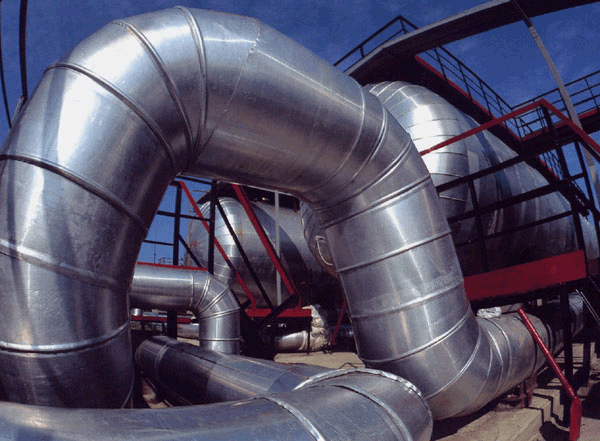
Abb.: Lukoil-Pipeline
(Pressefoto Lukoil)
"Lukoil Oil and Gas Company
Proven reserves: 15.522 billion barrels of crude oil and 24.253 trillion cubic feet of natural gas
Annual turnover: $15 billion
Stock Information: Lukoil ADR stock symbol is LYKOY. Lukoil is one of Russia’s largest integrated oil and gas companies. With 1.3 percent of global oil reserves, it is the second largest privately-owned oil company in the world in terms of proven reserves. Lukoil produces 20 percent of the total Russian oil output and is responsible for 18 percent of total Russian oil refining.
According to 2003 estimates, Lukoil’s proven reserves are 15,522 billion barrels of crude oil and 24,253 trillion cubic feet of natural gas.
The oil company’s key operating regions are Western Siberia (where 54 percent of the company’s reserves are to be found) and Perm Oblast. In addition, Lukoil is carrying out international exploration and production projects in Azerbaijan, Kazakhstan, Egypt, North Africa, and Colombia.
Lukoil’s sales network covers 58 regions in Russia, the CIS andBaltic states , Europe, and the U.S. In the U.S. Lukoil runs a network of 1,300 filling stations that earlier belonged to Getty.
Lukoil is the only private Russian oil company whose share capital is dominated by minority shareholders. It was also the first Russian company to be listed on the London Stock Exchange. The Lukoil ADRs are traded on world stock markets.Updated: 13.10.2005 22:43 MSK"
[Quelle: http://mosnews.com/mn-files/lukoil.shtml#news. -- Zugriff am 2005-12-06]

Abb.: ®Logo
Webpräsenz: http://www.tnk-bp.com/. -- Zugriff am 2005-12-05
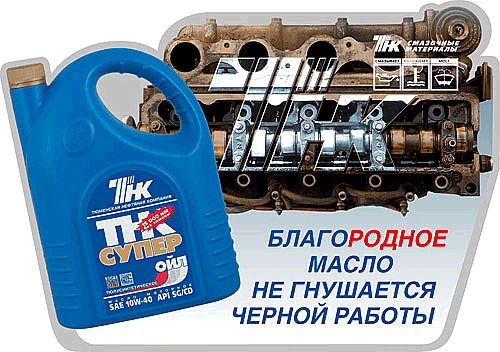
Abb.: TNK-Reklame
[Bildquelle:
http://www.tnk-oil.ru/marketing/materials?rid=22918&oo=1&fnid=119&newWin=0&apage=1&nm=70170.
-- Zugriff am 2005-12-11]
" TNK-BP is a major Russian vertically integrated oil company, established in September 2003 as a result of the merger of Russian companies TNK (Tyumen Oil Co.) [ТНК («Тюменская Нефтяная Компания»)] and SIDANCO [СИДАНКО] with the majority of BP’s Russian oil assets.The company is 50% owned by BP and 50% by a group of prominent Russian investors: Alfa Group, Access Industries and Renova (AAR) [Альфа Групп, Аксесс Индастриз и Ренова (ААР)]. The shareholders of
TNK-BP also own close to 50% of Slavneft [Славнефть]. This interest will eventually be integrated intoTNK-BP.
TNK-BP is headquartered in Moscow and is governed by a multinational management team, which consists of Russian and international executives who have worked in more than 50 countries worldwide. The team combines the best of Russian and international talent and experience and includes executives from BP, TNK, Sidanco and other international companies.Today,
TNK-BP is Russia’s second largest oil company. The company employs close to 100,000 people and operates in nearly all of Russia’s major hydrocarbon regions, including:
- West Siberia (in the Tyumen [Тюме́нская о́бласть],
Khanty-Mansiysk [ Ханты́-Манси́йский автоно́мный о́круг], Yamal-Nenetsk [Ямало-Ненецкий Автономные округа] and Novosibirsk [Новосибирская область] Regions);- the
Volga-Urals (in the Orenburg [Оренбу́ргская о́бласть] and Saratov [Сара́товская о́бласть] Regions and the Republic of Udmurtia [Удму́ртская респу́блика; Удмурт Элькун]);- East Siberia (in the Irkutsk Region [Ирку́тская о́бласть]); and
- the Far East (Sakhalin [Сахали́нская о́бласть]).
In 2004, average crude oil production totaled 1.44 million barrels per day (bpd), or 72 million tons per year. Current oil production is roughly 1.5 million bpd.
TNK-BP operates six refineries in Russia and Ukraine, and markets products through 2,100 retail service stations operating under TNK and BP brands. Through its retail network,TNK-BP is among the market leaders in petroleum product sales in European Russia, including Moscow, and is the market leader in Ukraine.Based on the independent reserve audit conducted by DeGolyer and MacNaughton, as of December 31, 2004,
TNK-BP ’s proved reserves were 8 billion barrels of oil equivalent on the basis of US SEC standards (life of fields basis), and 9.0 billion barrels under SPE standards. The company aims to replace 100% of its annual production with new reserves (all figures exclude gas).In 2004,
TNK-BP increased crude oil production by 13%, growing above the industry average.TNK-BP ’s strategy envisages annual capital investment of approximately $1.5 billion until 2007, excluding potential spending on asset acquisitions."[Quelle: http://www.tnk-bp.com/company/. -- Zugriff am 2005-12-05]

Abb.: ®Logo
Webpräsenz: http://www.sual.com/. -- Zugriff am 2005-12-05
"SUAL Group is a fully vertically integrated aluminium company that ranks amongst the world’s top ten aluminium producers. It comprises 20 businesses that are located in nine Russian regions and in Ukraine, Zaporozhye City [Запоріжжя], are involved in the production of bauxite, alumina, primary aluminium, silicon, semi-finished and finished aluminium products. The Group’s revenue for the year ended 31 December 2004 was USD 2.3 billion.* It has 60,000 employees.
Abb.: Modern electrolytic reduction technology (pre-baked anodes) at Nadvoitsy Aluminium
(Pressefoto SUAL)Annually, SUAL Group mines more than 5 million tonnes of bauxite, refines some 2,1 million tonnes of alumina, and produces more than 920,000 tonnes of primary aluminium. It also produces some 60,000 tonnes of silicon per annum, as well as a range of aluminium-fabricated products (including metal structures, foil, cable, cookware etc).
The Siberian-Urals Aluminium Company (SUAL) was formed in 1996 by a merger between the Irkutsk and Ural Aluminium smelters. At that time, SUAL Group incorporated only nine aluminium enterprises. Since then, SUAL has grown through a series of acquisitions that have improved its operating efficiency, while ensuring it produces sufficient raw materials to meet the Group’s evolving production needs.
SUAL Holding, the management company for SUAL Group, was established in September 2000 to improve
co-ordination between its businesses, shape its long-term development strategy and apply a unified investment policy.In 2002, SUAL Group began consolidating its results from Nadvoitsy Aluminium [Надвоицкий алюминиевый завод (НАЗ)] ]and from SevZapProm [СевЗапПром], including the Volkhov [Волховский алюминиевый завод (ВАЗ)] and Volgograd Aluminium Smelters [Волгоградский алюминиевый завод (ВгАЗ)] and the Pikalevo Alumina Refinery [Пикалевское объединение «Глинозем»].
SUAL Group is actively upgrading its businesses. The value of its investment programme for 2004 is more than USD 115 million, which covered modernisation of the Group’s alumina and aluminium operations and development of the company’s production capacity. The Group has reconstructed its cable plants and operations engaged in production of semi- and finished products. As part of its modernisation programme, SUAL Group has identified as priorities the reduction of emissions and improvements to its environmental impact.
Abb.: Lage von Komi Aluminium
[Bildquelle: http://www.sual.com/business/komi_aluminium/location/. -- Zugriff am 2005-12-05]Within the Group’s investment project portfolio is Komi Aluminium [«Коми Алюминий»]. The project foresees the development, construction and operation of a modern bauxite, alumina and aluminium complex in the Komi Republic [Респ́ублика Ко́ми], that will be based on the Middle Timan Bauxite deposit, the largest such resource in Eurasia. The design capacity of the complex is 6.0 million tonnes of bauxite, 1.4 million tonnes of alumina and
300,000—500,000 tonnes of primary aluminium per annum. Realisation of the Komi project will considerably reduce the dependency of Russia’s aluminium industry on external raw material supplies."[Quelle: http://www.sual.com/company/. -- Zugriff am 2005-12-05]

Abb.: ®Logo
Webpräsenz: http://www.interros.ru/eng/. -- Zugriff am 2005-12-06
Webpräsenz von Norilsk Nickel: http://www.nornik.ru/en/. -- Zugriff am 2005-12-06
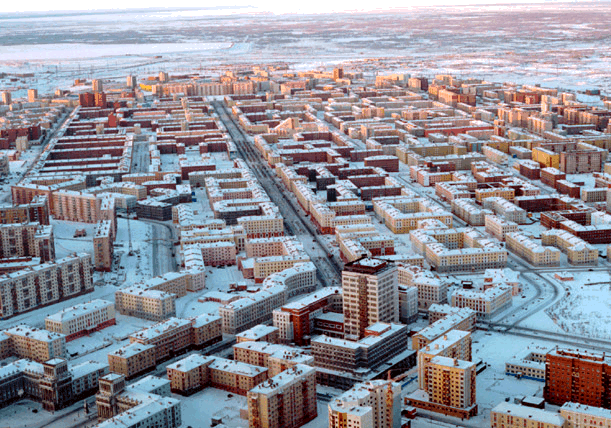
Abb.: Norilsk (Норильск)
(Pressefoto Norilsk Nickel)
"InterRos Holding Company
Major holdings: Norilsk Nickel Group ["Норильский никель"]
Stock Information: Norilsk Nickel ADR ticker stock symbol is NKEL InterRos is one of Russia’s largest private investment companies. The market value of assets under its management exceeds US$10 billion. Interros Group enterprises currently operate in all Russian regions and in a number of countries in Europe, Asia, and North America. Interros Group produces approximately 1.3 percent of Russia’s GDP, employing over 190,000.
InterRos manages several large companies, its main asset being the Norilsk Nickel Group, the world’s largest producer of platinum and palladium. In recent years, Norilsk Nickel has purchased mines in Australia and invested in the Stillwater Mining Company in the state of Montana, USA. The company also owns a Closed Joint-Stock company Polyus, which is the owner of the largest gold mine in Eurasia.
Norilsk Nickel Group produces nickel, copper, cobalt, palladium, platinum, and other precious metals (gold, silver), as well as selenium, tellurium, technical sulfur, hard coal, and other materials for industrial needs. The company is the world’s largest producer of nickel and palladium, and one of the largest producers of platinum. Its market share exceeds 20% of nickel, 10% of cobalt, and 3.1% of copper production worldwide.
InterRos’ other interests lie in petrol (RUSIA Petroleum), machine-building industry (Power Machines power generation equipment company), financial sector (Rosbank, Soglasie Insurance Company, Interross-Dostoinstvo pension fund), agriculture and food undustry (Agros agricultural industrial company), real estate (Open Investments), and mass media (Izvestia and Komsomolskaia Pravda news dailies, Prime-TASS news agency; Expert and Financial Director magazines; Autoradio, PM-radio, Novosti On-line radio stations, as well as several regional television and radio companies).Updated: 23.09.2005 21:36 MSK"
[Quelle: http://mosnews.com/mn-files/interross.shtml#news. -- Zugriff am 2005-12-06]
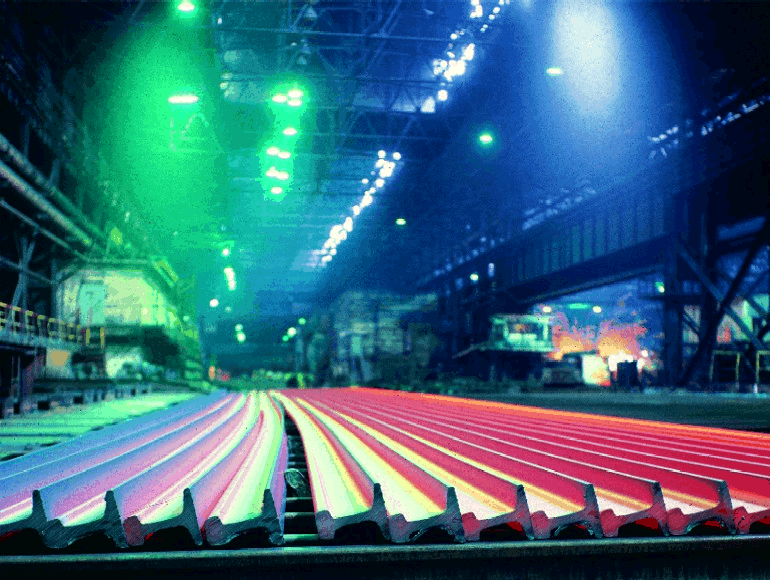
Abb.: Eisenbahnschienenproduktion
(Pressefoto EvrazHolding)
Webpräsenz: http://www.evrazholding.ru/en/. -- Zugriff am 2005-12-13
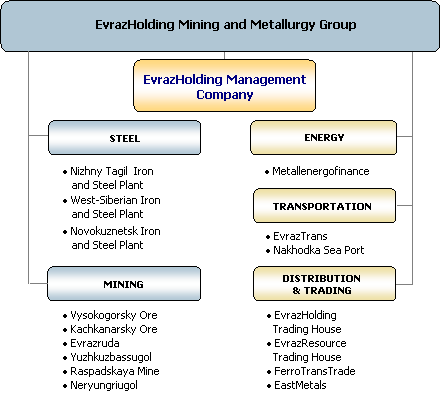
Abb.. Struktur von Evraz Holding
[Bildquelle:
http://www.evrazholding.ru/en/about05/structure/. -- Zugriff am 2005-12-13]
"The vertically integrated mining and metallurgy group EvrazHolding [ЕвразХолдинг] - Russia's largest steel producer - contains several of the biggest Russian iron and steel plants. It also includes ore mining and processing companies, coal mines, transport and power generating assets, and trading companies.
The Group’s sole executive body, EvrazHolding LLC, sets development strategy and carries out operational management of the three main steel facilities in the Group, which are the Nizhny Tagil, West-Siberian and Novokuznetsk Iron and Steel Plants as well as Vysokogorsky and Kachkanarsky Ore Mining and Processing Plants, Evrazruda (Evraz Ore) and Nakhodka Sea Port.
EvrazHolding is specialized in long products for the construction industry, special rolled products, rails and wheel-sets, and semi-products.
Output conforms to international quality standards, and has been certified by TUV-CERT and Lloyd’s Register. Products are sold on Russian and CIS markets, and are also exported to Korea, China, Taiwan, the Philippines, Vietnam, Iran, Saudi Arabia, UK, Italy, and Canada. About 40% of EvrazHolding’s production is exported.
EvrazHolding, catering for the growing needs of the Russian construction and transport industries, aspires to a responsible relationship between business, society and the state. The Group gives much attention to environmental and social issues. EvrazHolding recognizes corporate social responsibility, aimed at a balance between the long-term interests of all sides and not merely at short-term business goals."[Quelle: http://www.evrazholding.ru/en/about05/info/. -- Zugriff am 2005-12-13]
"EvrazHolding is the biggest steel producer in Russia and one of the 12 biggest steel companies in the world. The Group currently produces:
- 100% of total Russian production of rails.
- Over 80% of total Russian output of beams and channels.
- About 40% of total Russian rebar production.
- About 40% of total Russian output of long products."
[Quelle: http://www.evrazholding.ru/en/about05/positions/. -- Zugriff am 2005-12-13]
"The history of the Group began in 1992, when Alexander Abramov [Александр Григорьевич Абрамов] and a group of like-minded entrepreneurs set up a small firm, Evroazmetall LLC [Евроазметалл] to trade in non-ferrous metals. Successful development and strengthening of market positions of the new company were largely thanks to the creativity and excellent educational background of its founders, most of whom had completed one of Russia’s foremost higher-education institutions – the Moscow Institute of Applied Physics [Московский физико-технический институт]. Evroazmetall also built itself a reputation for unfailing and timely fulfillment of all obligations.
In 1993 Evroazmetall made a strategic partnership agreement with the trading company, Ferrotrade, which gave access to international markets. The company’s turnover and field of activity steadily expanded.
While specializing in metal goods trading, and supplies of raw materials and equipment, Evroazmetall also became involved in settlement of debts between mining and metallurgy enterprises. The company accumulated debts of steel plants, coal mines, and ore mining and processing concerns. This led to a decision to acquire equity stakes in mining concerns.
In 1995 the owners of Evroazmetall set up a private firm, EAM Group [Группа ЕАМ], which united several companies in the metallurgy, coal and ore industries. Alexander Abramov’s team was enriched by a number of professional managers with extensive experience of work in various Russian industrial and financial structures.
A strategic partnership agreement with Duferco at the end of 1995 gave Alexander Abramov and his team a controlling stake in the Nizhny Tagil Iron and Steel Works (NTMK [НТМК]), although actual control of this troubled asset only became possible in 1997. The situation at Nizhny Tagil [Нижний Тагил] gradually stabilized and a process of reconstruction and modernization was put in motion.
By 1999 EAM had accumulated significant experience of managing a major industrial enterprise in crisis conditions, and felt ready to take on a second major industrial asset. The company’s existing business in the Kuzbass coal market led naturally to a management role at the West-Siberian Iron and Steel Works (ZSMK [ЗСМК]), which is located in the Kuzbass region and was in a state of bankruptcy at the time.
This management role convinced EAM that ZSMK had the potential to become a highly profitable enterprise, given the right management and strategy. EAM therefore decided to buy debts of ZSMK from its main creditors.
In 1999 the other main steel maker in Kuzbass region, the Kuznetsk Iron and Steel Works (KMK [КМК]), also found itself in a financial crisis. EAM, which held a significant part of KMK’s debt, took on operating management of the plant.
Global trends towards consolidation in metallurgy (following the example of other sectors), growth of competition and the battle for markets called for new approaches to corporate organization. In November 1999 the Group set up EvrazHolding LLC [ЕвразХолдинг] as a single executive organ with responsibility for management of the Nizhny Tagil, West Siberian and Novokuznetsk Iron and Steel Works (NKMK, set up from the assets of KMK), Vysokogorsky and Kachkanarsky Ore Mining and Processing Plants, Evrazruda (Evraz Ore), as well as Nakhodka [Находка]Sea Port.
In 2000 EvrazHolding enlarged its equity holding at the Nizhny Tagil Iron and Steel Works.
In 2001 ZSMK came out of external management, which had been imposed in connection with its earlier state of bankruptcy, and EvrazHolding consolidated a controlling equity stake in the plant.
In 2002 the Group set up Evrazruda [Евразруда](the ore division of EvrazHolding).
In 2003 the Novokuznetsk [Новокузне́цк] Iron and Steel Works (NKMK), set up on the basis of KMK assets, was included in EvrazHolding, as was the smaller Nizhnesaldinsky Iron and Steel Works.
Also in 2003 EvrazHolding consolidated stakes in the Vysokogorsky Ore Mining and Processing Plant (VGOK [ВГОК]) and Nakhodka Sea Port (NMTP [Находкинского морского торгового порта]).
In 2004 Kachkanarsky Ore Mining and Processing Plant ("Vanady" [Ванадий]) was included in EvrazHolding."[Quelle: http://www.evrazholding.ru/en/about05/history/. -- Zugriff am 2005-12-13]
Webpräsenz: http://www.lada-auto.ru/. -- Zugriff am 2005-12-05
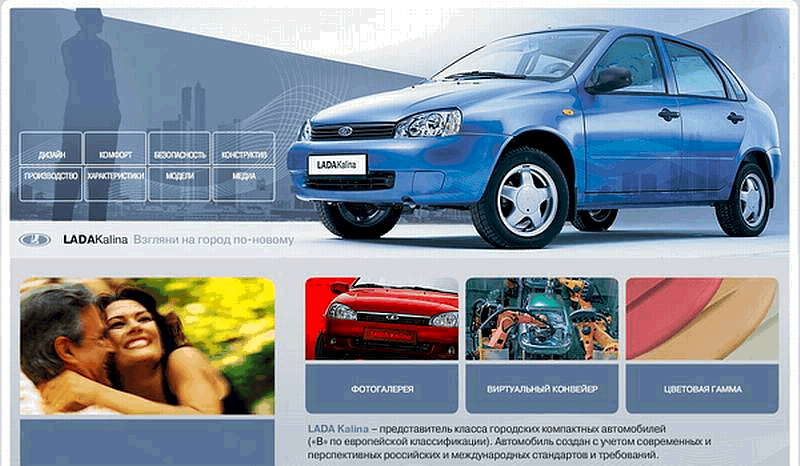
Abb.: Lada-Reklame
[Bildquelle:
http://www.ladanews.ru/cgi-bin/lnews.pl?inf=lnews1.inf&step=branch&bind1=868&number=201.
-- Zugriff am 2005-12-11]
"AvtoVAZ (АВТОВАЗ) is a Russian automobile manufacturer, also known as VAZ, Volzhsky Automobilny Zavod (ВАЗ, Во́лжский автомоби́льный заво́д ), and better known to the world as Lada was set up in the late 1960s in collaboration with Fiat. It produces nearly one million cars a year, including the Samara, Lada 110 and the Niva, a 4x4 vehicle. The variations of their first car, the model VAZ-2101, based on the 1966 Fiat 124 and introduced in 1970, are still produced and remain the cars most associated with its Lada brand.
The VAZ factory is one of the biggest in the world, has over 90 miles (144 km) of production lines and is unique in that most of the components for the cars are made in-house.
Origins
Abb.: Lage von Togliatti
(©MS Encarta)The plant was set up as a collaboration between Italy and the Soviet Union and built on the banks of the Volga [Во́лга] river. A new town named Togliatti [Толья́тти], named after an Italian communist, was built around the factory. The Lada was envisaged as a "people's car" like the Citroën 2CV or the VW Beetle.
The lightweight Italian Fiat 124 was adapted into something intended to survive treacherous Russian driving conditions. Among many changes, aluminium brake drums were added to the rear, and the original Fiat engine was dropped in favour of a newer design purchased from Fiat. This new engine had a modern overhead camshaft design but was never used in Fiat cars. The suspension was raised (to clear rough Russian roads) and the bodyshell was made from thicker, heavier steel. The first Lada models were equipped with a starting handle in case the battery went flat in Siberian conditions, though this was later dropped. Another feature specifically intended to help out in cold conditions was a manual auxiliary fuel pump.
Engines fitted to the original Ladas start with the 1.2 L carburettor in the original and go up to the 1.7 L export model set up with a General Motors single point fuel injection system. Diesel engines were later fitted for the Russian market only. The drivetrain is a simple rear wheel drive setup with a stiff rear axle. The engine is an inline four with two valves per cylinder and a single overhead camshaft.The Fiat-based Ladas feature various headlight, trim and body styles. The original, Fiat style models included VAZ 2101 sedan and VAZ-2102 station wagon. 1972 saw introduction of deluxe version of the sedan, VAZ-2103, which was based on Fiat 124 Speciale and featured new 1.5L engine and twin headlights. In 1974, the original VAZ-2101 was updated with new engines and interiors; VAZ-2102 underwent the same improvements in 1976. The body style with two round headlights was manufactured until 1988, all others remain in production in slightly updated form.
The VAZ-2106 introduced in 1976 was an updated verion of VAZ-2103, featuring different interiors and new 1.6L engine. 2106 is the oldest and the most popular rear-drive model of AvtoVAZ, its production continued until 2001 and still carried on by licensees.
VAZ-2105, still based on the 2101 but updated to 80s styling, was introduced in 1980. Square headlights and new body panels distinguish this style from the old models. A deluxe version, VAZ-2107, was out in 1982; it featured a better engine, refined interiors and Mercedes-like radiator grille. In 1984, the VAZ-2104 station wagon completed the line-up.
In the domestic market, these classic models were called Zhiguli [Жигули́]. The Lada name was used for exports only, but a large share of Ladas was reexported from Eastern block countries, so the brand was well-known in the domestic market as well.
Non-Fiat modelsAvtoVAZ designers proved that they have some original ideas when VAZ-2121 Niva was introduced in 1978. This highly popular car was made with off-road use in mind, featuring full time all wheel drive, an original body style and the most powerful 1.7L engine in the VAZ range. The Niva has also been available with 1.9L Peugeot sourced diesel engine. The Niva is still in production.
Based on the success of the Niva, the design department prepared the new family of front wheel drive models by 1984, a completely domestic design; the body is not unsimilar to Fiat Regata though. Production started with VAZ-21083 Sputnik 3-door hatchback; the series were later renamed Samara. The Samara engine was mostly designed and produced in-house, had a new single overhead cam design and was driven by a more modern rubber belt. The combustion chambers were developed in collaboration with Porsche. The line-up features completely new body and interiors, front McPherson suspension and rear torsion bar, rack and pinion steering and updated 5-speed gearshift. 5-door VAZ-21093 hatchback followed in 1987, and 4-door 1.5L sedan, VAZ-21099, was introduced in 1990. The same year, the front sides and radiator grille were restyled on the whole Samara range.
The 2108-2109 models were in production until 2001, when they were restyled with new side panels, interiors and 1.5L fuel injection engines (though fuel injection was available as early as 1995). The Lada 2109 hatchback was rebadged as Lada 2114, and Lada 21099 sedan was rebadged as the Lada 2115. The 2104-21099 model range was transferred to IzhMash [ИЖМАШ] and ZAZ [ЗАЗ] and is still being manufactured. In 2004 VAZ also introduced Lada 2113, a restyled version of Lada 2108.
VAZ-1111 Oka micro-car, which resembles the Fiat Panda (though has no relation to it), was introduced in 1988, and in 1991 the production was transferred to KamAZ [Камаз] and SeAZ factories.
The VAZ-2120 Nadezhda minivan is based on original Niva and is in low-volume production since 1998. A five-door version of the Niva, the VAZ-2131, has been in production since 1995.
The break-up of the USSR delayed the production of new 110-series by a couple of years. The VAZ-2110 sedan was introduced in 1996, the 2111 station wagon followed in 1998 and the 2112 hatchback completed the range in 2001. These models are basically based on Samara technology with a new body and fuel injection engines as standard, though carburated versions have also been available up until 2001. The 110-series remains in production and has been continually updated over the years- for example, engines used to be 1.5 liter units with either 8 or 16 valves, but these have now been upgraded to 1.6 liter units that meet stricter emissions rules.
Market shareChanges to emissions- and safety-legislation meant that AutoVAZ withdrew from most Western markets by the late 1990s; often, there were also problems with spare parts. In the USA they were never sold due to the cold war, but they were available in Canada (where the Niva was quite popular) however Canadians travelling in the USA in a Lada found out that some gas stations refused to sell fuel to them due to anti-Soviet sentiment. The rise in popularity of Far Eastern imports from newly established manufacturers such as Daewoo, Proton, Kia and Hyundai contributed to Lada's demise in the West. These Korean and Malaysian-manufactured vehicles offered modern Japanese-developed technology, reliability and high equipment levels which Lada could not hope to compete with.
Though the original Lada, and as of the early part of the new millennium the Samara, have now been withdrawn from Europe, the Lada 110 and the Niva are still sold on the European market, as are the more modern models. The Lada is widely available in many Central- and South American countries as well as Africa, the Middle East and in all of the former Soviet Union.
In early post-Communist Russia, a bizarre export market for unwanted Lada vehicles began to emerge. A shortage of both cars and spare parts led to armies of Russian speculators coming to the West (where the cars were considered unfashionable to the point of ridicule and therefore worthless), to buy thousands of Lada cars for export back to their home country. Most of export Lada Samara cars were reexported back in 1994-1996 and they sold very well, due to popular belief that export Ladas are produced with better care than domestic versions. For this reason, Ladas are a relatively rare sight nowadays in Western European countries, although AvtoVAZ has since developed a new generation of Lada cars and is bidding to return to these markets.
Although current Lada cars miss many features standard on a modern car, such as power steering, anti-lock brakes, air conditioning and automatic transmission, they have been popular in Russian because of their low price; that is beginning to change in spite of persistent build quality problems and the sales of domestic models are showing a steady decline over the last few years.
There are lot of garage firms that offer customization in the form of different head and tail lamps, front fascia, spoilers, seats and steering wheels. Some authorized services can even retrofit many kinds of modern equipment using imported parts, with no loss of producer warranty.
Recent developmentsAs AvtoVAZ was allowed to sell cars to private dealers in late 1980s, mathematician Boris Berezovsky [Бори́с Абра́мович Березо́вский] arranged to resell the cars to the public through his Logovaz [ЛогоВаз] dealerships. In 1993 he started a campaign to collect funds for the people's automobile and created the AVVA venture, which stands for All-Russian Automobile Alliance; the AvtoVAZ held a major share in the venture. The plans were to build a completely new plant for production of Opel Corsa-class car, VAZ-1116. However, the financial crisis of 1998 put these plans to an end. The development concepts of 1116 made a foundation of the Lada Kalina range.
GM-AvtoVAZ, a joint-venture with General Motors, adopted updated version of Niva, VAZ-2123, that was considered for production since the 1990s. Named Chevrolet Niva, it's being built on the venture's plant since 2001 and is exported to Europe and Latin America. In 2004, the Chevrolet Viva, a four-door version of the Opel Astra G, was introduced.
VAZ has also tried to get into the sportier markets: several Ladas were factory-tuned and given a Momo steering wheel. A convertible was also produced. In 2003, VAZ presented the concept car Lada Revolution, an open single seater sportscar powered by a 1.6 L engine producing 215 hp. There are other experimental cars like VAZ-210834 Tarzan SUV concept, VAZ-211223 110-series coupe, VAZ-1922 monster truck and VAZ-2359 pick-up both based on Niva etc.
2005 will see the introducion of the new B-class Kalina lineup to the market. AvtoVAZ has built a new modern plant for this model and hoping to sell some 200,000 cars annually. Test production of Lada 1118 sedan started in November 2004 and full-scale assembly was launched in May 2005. The Lada 1119 hatchback and Lada 1117 station wagon with updated DOHC 1.6L engines are to follow in 2005–6.
The restyled 110-series model, Lada 2170 Priora, is set for production in Q3 2006.
AvtoVAZ was considering the local production of Ecotec Family 1 (FAM-1) engines using the equipment transferrend from Szentgotthard, Hungary plant. A transmissions plant was to be bought from Dawoo Moto India, a former Daewoo Motors subsidiary that was not sold to GM. The engines and transmissions were to be used in both GM-AvtoVAZ and Lada cars. As of Summer 2005, these plans are cancelled and VAZ is seeking another way to acquire some modern powerplant technology."
[Quelle: http://en.wikipedia.org/wiki/AutoVAZ. -- Zugriff am 2005-12-05]
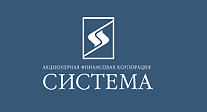
Abb.: ®Logo
Webpräsenz: http://www.sistema.com/. -- Zugriff am 2005-12-12
Zu Владимир Евтушенков — Wladimir Jewtuschenko (Vladimir Evtushenkov) (1948 - ) siehe:
Payer, Margarete <1942 - >: Kulturen von Arbeit und Kapital. -- Teil 3: Kapitaleignerkulturen. -- 7. Postsowjetische Oligarchen. -- 2. Russland (Россия). -- 2. Personen. -- URL: http://www.payer.de/arbeitkapital/arbeitkapital0307012.htm
"Sistema is the largest consumer services private sector company in Russia and the CIS with over 50 million customers. Founded in 1993, Sistema develops and manages market-leading businesses in fast-growing service-based industries, including telecommunications (MTS, MGTS, Comstar United Telesystems), technology (NIIME and MIKRON, STROM telecom, Sitronics), insurance (ROSNO), banking (MBRD), real estate (Sistema-Hals), retail (Detsky Mir Group) and media. Given the scale, scope and market position of our existing operations, we are uniquely positioned to exploit the growth in consumer and corporate purchasing power in the countries in which it operates. The company reported revenues of US$ 3.8 billion in 2003 and US$ 4.1billion in the first nine months of 2004, with total assets exceeding US$ 7.6 billion as at September 30, 2004." [Quelle: http://www.sistema.com/section.html?s=108. -- Zugriff am 2005-12-12]
Sistema Shareholding Value
Abb.: Anteilseigner
V.Evtushenkov [Владимир Евтушенков] 6 091 755 63,1% A. Leiviman [ЛЕЙВИМАН Александр Львович] 345 150 3,6% Е. Novitsky [НОВИЦКИЙ Евгений Григорьевич] 308 683 3,2% А. Gorbatovsky [ГОРБАТОВСКИЙ Александр Иванович] 234 282 2,4% А. Goncharuk [ГОНЧАРУК Александр Юрьевич] 193 000 2,0% D. Zubov [ЗУБОВ Дмитрий Львович] 133 875 1,4% N. Мikhailov [МИХАЙЛОВ Николай Васильевич] 6 800 0,1% GDR Holders 1 828 825 19,0% Other Shareholders 507 630 5,3% [Quelle: http://www.sistema.com/section.html?s=143. -- Zugriff am 2005-12-12]
"FAQ - Frequently Asked Questions What is Sistema?
Sistema is the largest private sector consumer services company in Russia and the CIS, with over 35 million customers. Sistema develops and manages market-leading businesses in selected service-based industries, including telecommunications, technology, insurance, banking, real estate, retail and media.
When did Sistema list on the London Stock Exchange?
Abb.: Börsengang der Sistema an der Londoner Börse; 2005-02-14
(Pressefoto Sistema)Sistema's Global Depositary Receipts (GDRs) were admitted to the UKLA Official List on Monday, February 14th, 2005.
What is Sistema's ticker symbol?
Sistema's shares are listed under the symbol "AFKS" on the 'B' list of the Russian Trading System (RTS) and under the symbol "CUCT" on the 'B' list of the Moscow Stock Exchange (MSE). The GDRs are listed on the London Stock Exchange under the symbol "SSA".
What is the market value of Sistema?
Sistema has a total market capitalization of approximately US$8.3 billion at April 14th , 2005.
What is Sistema's revenue?
For the first six months 2005 Sistema generated US$3.35 billion in consolidated revenue.
What is the free float of Sistema?
Sistema's share capital consists of 9,650,000 issued shares. The number of Global Depositary Receipts (with 50 GDRs representing one common share) listed on the London Stock Exchange totals 91,578,150, which represent 1,831,563 common shares.
How much has the company raised from its IPO?
The total size of the Offering, including secondary shares sold by the shareholders of Sistema, amounted to US$ 1.56 billion. Net proceeds from the Offering to the Company totalled US$ 1.28 billion
What banks acted as Sistema's underwriters?
Morgan Stanley and Credit Suisse First Boston were appointed as international advisors of the listing.
How does Sistema intend to use the proceeds from the IPO?Parts of the proceeds from the offering will be invested into our existing non-telecommunications businesses to accelerate their development. Our businesses are also expected to have access to additional potential sources of capital to finance capital investments and potential acquisitions, including cash flow from operations, debt financing, vendor financing and additional equity to be provided by our partners.
Many of our businesses are developing rapidly and operate in markets that are at an early stage of development and/or are subject to significant competitive or technological change. Our investment program for our existing businesses may change to respond to the evolution of the market for the services offered by our businesses, regulatory developments and competitor behavior, among other factors. Subject to meeting our investment criteria, we may instead use a portion or all of the net proceeds of the offering to pursue acquisitions in the telecommunications industry in Russia and the CIS.What are Sistema's primary businesses?
Abb.: Struktur der Sistema
[Bildquelle. http://www.sistema.com/section.html?s=110. -- Zugriff am 2005-12-12]We operate principally in the following sectors: telecommunications, technology, insurance, real estate, banking, retail and media. Our other businesses consist of travel services, international operations, radio and space technology, pharmaceuticals and biotechnology, as well as the operations of our parent company.
Telecommunications.
The companies in our Telecommunications Segment form the largest privately held telecommunications group in Russia in terms of revenues and number of subscribers. The segment has two divisions: wireless communications services and fixed line communications services. Our wireless telecommunications services division consists of MTS, the largest wireless operator in Russia and the CIS, and Sky-Link, a CDMA 2000 operator in Moscow, St. Petersburg and the surrounding regions. We beneficially own a 50.6% interest in MTS [МТС], which generated net standalone revenues of $2,546.2 million and $2,807.3 million for the year ended December 31, 2003 and for the nine months ended September 30, 2004, respectively.
Our fixed line communications services division consists of MGTS [Московская городская телефонная сеть], the incumbent PSTN operator in Moscow, and Comstar UTS, a leading provider of unregulated telecommunications services in Moscow. MGTS had approximately 4.2 million active lines in service as of September 30, 2004, and Comstar UTS had over 26,200 corporate and public sector customers and approximately 394,019 Internet subscribers, of which 47,338 were ADSL subscribers. Sistema has management control of these two businesses. We beneficially own 46% of MGTS. Our voting interest in MGTS is equal to 56%. Comstar UTS [Комстар Объединенные Телесистемы] is currently being formed as a single legal entity and integrated business through the restructuring of our interests in existing alternative operators and Internet service provider businesses including Comstar, MTU-Inform, Telmos, Golden Line and MTU-Intel. We plan to complete the restructuring during 2005. Upon completion of the restructuring, we expect that Sistema will own at least a 51% stake in Comstar UTS and MGTS will own at least an additional 45% stake in Comstar UTS. Our telecommunications Segment accounted for 81.0% of our consolidated revenues and 98.6% of our consolidated operating income before depreciation and amortization for the nine months ended September 30, 2004.Technology.
Our Technology Segment consists of CSC and its subsidiaries. The segment has four divisions: telecommunications equipment and software; IT and systems integration; semiconductor design and manufacturing; and electronic devices and consumer electronics. For the nine months ended September 30, 2004, our Technology Segment accounted for 7.7% of our consolidated revenues.
Insurance.
Through ROSNO [РОСНО] and its subsidiaries, we are one of the leading providers of insurance, reinsurance and related products in the Russian insurance market. ROSNO's principal activities are non-life and life insurance, as well as insurance-related services, such as obligatory insurance. We have a strategic partnership with ROSNO's 47% shareholder, Allianz, one of the largest European insurance companies. Our Insurance Segment accounted for 4.9% of our consolidated revenues for the nine months ended September 30, 2004.
Banking.
Our Banking Segment is represented by MBRD [Московский Банк Реконструкции и Развития], a joint stock bank incorporated in 1993. MBRD has historically performed internal treasury functions for us and our subsidiaries. However, we intend to develop MBRD's business, particularly in the retail banking sector. MBRD has a history of steady development despite several recent financial crises in Russia. Our Banking Segment accounted for 1.2% of our consolidated revenues for the nine months ended September 30, 2004.
Real Estate.
We are a leading real estate owner, developer and manager predominantly focused on the Moscow market in the segments of Class A and B offices, elite housing, cottages and land development. We have been in the real estate business since the early 1990s, making real estate one of our first businesses. Since 1994, we have successfully completed more than 20 projects totaling over 150,000 sq.m. of space utilizing funding from internal sources and from third parties. Our real estate strategy is two-pronged: continue to develop, redevelop and build profitable projects on our current sites or sites to be sourced by us in the future through our extensive network of market contacts and redevelop those properties in our significant real estate holdings that are no longer fully used by our operations.
Retail.
We are the largest retailer of children's goods in Russia through our children's goods retailer Detsky Mir [Детский мир]. Detsky Mir is among the most recognized brands in Russia. As of September 30, 2004, we operated seven stores in Moscow, including the flagship Detsky Mir store in central Moscow, and two stores outside of Moscow with a total retail space of 21,719 sq.m. We plan to expand Detsky Mir by opening new stores in Moscow and other Russian cities and to undertake a significant refurbishment of our flagship store.
Media.
Our media business has historically operated in three main areas: advertising, print distribution and other media, which includes a number of secondary companies that operate in areas such as publishing, film production and news services. As a result of a recent strategic review of our activities, we will be focusing on the development of our pay-TV and interactive services, including multiple distribution platforms (video over DSL, MMDS, HFC cable) and content aggregation and production.
Other Businesses.
Our other businesses include travel services, international operations, radio and space technology, pharmaceuticals and biotechnology, as well as the operations of our parent company. Our Other Businesses Segment, which includes our real estate, retail and media businesses for financial reporting purposes, accounted for 6.8% of our consolidated revenues for the nine months ended September 30, 2004.
When was Sistema founded? What is Sistema's history?
The Company was founded in 1993.
Landmark Periods
1993-1997Capital Accumulation and Asset Privatization. Vigorous growth, investment in fast-growing projects, and creating conditions for raising capital in stock markets and managing sectors capable of ensuring fast returns. In 1995, Sistema JSFC had 38 companies under its wing, while in 1997 it already had over 100.
1998-2000
Acquisitions and Direct Investments. Consolidation of positions in sectoral markets. Portfolio structuring according to sectoral principles. Establishment of management companies in various business strands and continued restructuring. ROSNO, a leading insurance company in Russia, was the major acquisition of the period. Under further deals, Sistema JSFC acquired several media and pharmaceutical companies.
2001 to Date
Business Portfolio Development and Management. Focus on actively managed companies. Continued business restructuring to promote the more promising business strands and put together a balanced portfolio of operating companies. Listing of Sistema on the London Stock Exchange.
Corporate highlights
1993-1994
- Formation of an ownership structure. Acquisition of fixed assets in telecommunications, electronics, tourism, commerce, oil and petroleum products, construction and real estate. Sistema JSFC founded Vimpel Communications (VimpelCom), Russia's first company to offer mobile telephone communication services.
- Investments started to pour into Intourist, Detsky Mir, MGTS, and electronics enterprises. Sistema-Hals provided a platform for a sub-holding company to be built on, bringing together businesses active in the construction and real estate market in Moscow since 1990. Oil field development was launched in the Komi Republic, and construction started on a network, Kedr-M, of gas stations in Moscow. A new company, Sistema-Invest, was established to manage the new projects.
- Over its first two years in business, the corporation got into shape all the institutions it required to run businesses and keep up corporation growth, in particular, a Board of Directors for the Management Company, Boards of Directors in all business units, and core industry committees and commissions.
1995
- A long-term development strategy was developed whereby efforts were focused successively on sectors having the greater asset growth potential in order to reinforce their market positions; conditions were created for capital to be raised in stock markets; and special attention was given to sectors capable of yielding immediate financial returns.
- An insurance company, named Leader, was set up.
- Large funds were borrowed from foreign banks to finance investment projects.
1996
- That was the year when AO VimpelCom became the first Russian company to achieve a successful IPO on the New York Stock Exchange (NYSE), indeed, a watershed year for Sistema JSFC. By selling a block of shares in VimpelCom, Sistema JSFC made a strategic step to create a new company, OAO Mobile TeleSystems (MTS), operating to a more advanced, GSM standard. Sistema JSFC acquired a controlling interest in Mobile TeleSystems from Russian shareholders and started investing funds and efforts into MTS in partnership with Deutsche Telekom.
- Telecommunications assets took up a greater part of the Sistema JSFC portfolio, largely swaying its choice of options for future developments.
1997
- A general cooperation agreement was signed with ING Group.
1998
- Building up from its telecommunications department, Sistema JSFC set up a holding company, Sistema Telecom, to manage its telecommunications companies' stocks.
- An insurance holding company was established around ROSNO company.
- MGTS offered its Eurobonds to the public for a total of $150 million.
- Sistema JSFC is one of only a few Russian companies to have prepared its reports and financial statements consistent with international accounting standards for five years running. Deloitte & Touche has been auditing the company's books to US GAAP standards since 1998.
2000
- MTS's IPO on the New York Stock Exchange proved quite successful
- Sistema JSFC signed a general agreement with Volvo Truck Corp. Another cooperation agreement was signed with Siemens AG. Sistema JSFC instituted a non-public pension fund.
- At the end of 2000, the company's assets were valued at $2.2 billion, with a net profit of $203 million on sales of around $1.2 billion. Its basic performance indicators showed a tenfold improvement on 1993.
2001
- Under a deal signed in this period, one of the world's largest insurance groups, Allianz AG, became the company's strategic partner in ROSNO. The solid investor Sistema succeeded in persuading to come to the Russian market has had a favorable impact on insurance market development in Russia.
- A Board of Trustees was set up for the Science Center Concern under Nobel Prize winner Zhores Alferov, a member of the Russian Academy of Sciences. A start was made on strategic cooperation with AO Kamov.
2002
- Its efficiency on the upgrade, the corporation expanded the scale of its operations by making several significant acquisitions.
- Sistema JSFC increased its interest in MTU-Intel (from 48 per cent to 87 per cent), VAO Intourist (55 per cent to 91 per cent), MBRR Commercial Bank (47 per cent to 52 per cent), and East-West United Bank (25 per cent to 30 per cent). A further 50 percent stake was acquired in Golden Line along with a 100 percent interest in STROM Telecom s.r.o., the Czech Republic. The company sold its Businovsky meat-packing plant.
- The company expanded its presence in the debt market. It successfully issued ruble-denominated bills to raise $25 million and floated its first ruble-denominated bond issue for a total of Rb 1.2 billion.
- As part of its successive structural reforms, Sistema JSFC reorganized its management company by adding MKNT & Co. and Sistema-Invest companies to it in order to streamline its organizational structure and create a transparent vertical ownership structure.
- Restructuring continued in the business strand management setup. To raise growth rates and efficiency of the electronics business, an area Sistema JSFC considers its first priority today, the corporation set up a management company, OAO SCC, which brought OAO Science Center Concern and STROM Telecom s.r.o. under its control. As it continued to restructure its assets in the petroleum sector, Sistema JSFC sold its Kedr-M network of gas stations.
- With information transparency as its prime goal, Sistema JSFC joined the World Economic Forum (WEF) and became one of only a few Russian companies that joined the corporate governance promotion program and follow all WEF recommendations.
- Again, Sistema was among the first several Russian companies to invite outside directors and the first Russian OTC company to reveal the identities of its shareholders.
- During the year, Sistema continued to reinforce its management team and optimize its corporate structure. The company's realistic strategy, management quality, and high level of financial transparency were acknowledged by international rating agencies. The Fitch Ratings agency gave Sistema JSFC its long-term B credit rating in national and foreign currencies, and Standard & Poor's awarded it a B-V rating, with a stable forecast.
2003
- Its tenth year in business proved yet another period of stable growth. Sistema JSFC bought a further 10 per cent interest in MTS, Eastern Europe's biggest cellular telecommunications operator, which Sistema JSFC had been building up, jointly with its partner, Deutsche Telekom, for seven years already.
- After a successful issue of $350 million in Eurobonds, Sistema JSFC became the first Russian holding company to enter the Eurobond market. It also had a successful issue of credit notes for a total of $100 million.
- Sistema JSFC began forming an International Advisory Council by inviting some of acknowledged Russian and world business leaders to sit on it. As it works to upgrade corporate governance standards, Sistema JSFC tries to absorb advanced world experience in investment and business development for its purposes.
- The company purchased a 50 per cent interest in Comstar Company. The deal was vital for consolidating Sistema JSFC-controlled alternative communications operators into an integrated digital communications operator built around Comstar, MTU-Inform, MTU-Intel, Telmos, and Golden Line. Also, it bought a 50 per cent block of shares in ZAO Cosmos-TV.
- Acquisition of a 33 per cent stake in OAO Belkamneft, an oil company operating in Udmurtia, was a consistent step under the corporation's oil business restructuring program.
- Fitch Ratings, the international rating agency, confirmed Sistema JSFC's long-term B credit ratings in foreign and national currencies, with a stable forecast.
- Moody's Investors Service, the international rating agency, gave Sistema JSFC its B1 rating, with a stable forecast.
2004
- istema JSFC issued Eurobonds with a value of $350 million.
- A deal was finalized to sell the corporation's oil production assets (100 per cent of the shares in OAO Sistema-Neft and 50 per cent of the shares in AO United Oil Company, and also its 100 percent stake in OOO Consortium K-12 and 100 percent stake in OOO Baikal-Oil) in line with its strategy to focus efforts on developing priority business strands. Under this strategy, Sistema JSFC sold its Kedr-M network of gas stations in late 2002 and early 2003. Withdrawal from the oil business was a further vital step to optimize Sistema's asset structure, enabling it to channel resources into business development in high-tech products and services.
- The company reported revenues of US$ 4.1 billion for the first nine months of 2004 and total assets of more than US$ 7.7 billion as at September 30, 2004.
- Sistema's shares are listed under the symbol "AFKS" on the 'B' list of the Russian Trading System (RTS) and under the symbol "CUCT" on the 'B' list of the Moscow Stock Exchange (MSE).
- Sistema JSFC continues to develop cooperation with Russian and foreign counterparts, optimize its corporate structure, actively recruit the services of global strategic and financial consultancy leaders, and reinforce its management team with a view to enhanced performance.
2005
- Sistema's Global Depositary Recipts (GDRs) admitted to the UKLA Official List of companies trading on the London Stock Exchange on February 14.
Who is the President of Sistema?Vladimir Evtushenkov [Владимир Евтушенков] is the corporation's majority shareholder and President. He has served as President since January 2005. Mr. Evtushenkov served as Director and Chairman of the Board of Directors from January 1994 to January 2005. From 1993 until 2000, he was the chairman of the board of directors of MKNT OJSC. In addition, Mr. Evtushenkov serves as a member of the board of directors of OJSC Sistema Mass Media and ECU GEST Holding S.A., both of which are affiliated with Sistema.
Where is the company based?
Sistema's headquarters are in Moscow, Russia.
How many people does Sistema employ?
Sistema has a workforce of over 70,000 people.
What is Sistema's strategy?
Our strategy is to capitalize on our competitive advantages to build market-leading businesses in select sectors which exploit the growth in consumer and corporate purchasing power in the Russian and CIS markets.
We Employ a Return-Based Approach to Investments. We employ a disciplined approach to our investment decisions with the aim of maximizing returns for our shareholders. Our internal performance benchmarks require that our businesses achieve certain operational, revenue and profitability targets, which also reflect the nature of these individual businesses. Progress against these targets is monitored and used to develop annual budgets, long-term business plans and capital allocation strategies. Companies that fail to achieve their objectives in a specified time frame generally cease to be beneficiaries of direct investments from Sistema and, should they continue to fall short of our objectives, may be sold. Similarly, we may dispose of businesses in industries that have largely fulfilled their growth potential.
We Have a Focused Approach to Growth Opportunities. We have finite financial and managerial resources and, therefore, we concentrate our resources on select sectors in which we believe we can capitalize on our competitive advantages to build market-leading businesses. We exploit our close understanding of the markets in which we operate, as well as our established corporate and government relationships to source attractive investment opportunities in a variety of industries at an early stage. In doing so, we capitalize on our management team, which brings substantial experience of growing businesses across a broad range of sectors in Russia and the CIS. Our business development strategy is focused on achieving growth both through organic development of our businesses and through acquisitions. We provide capital, management, administrative and other resources to accelerate the business plans of our companies through business line extension, geographic expansion, participation in industry consolidation and crossselling with our other businesses. We constantly evaluate potential entry into new high-growth sectors that may meet our investment requirements. We also evaluate selective international expansion opportunities in cases where we can capitalize on our competitive strengths. Where appropriate, we will accelerate the development of our businesses by capitalizing on our ability to access the international capital markets.
We Actively Manage Our Investments. We have management control of our key businesses and operate as an active investor. We contribute significant management and other resources to accelerating the development of our businesses, particularly in the early stages of their life-cycles. For example, the rapid growth of our telecommunications businesses is largely a function of our ability to attract and retain skilled management. Continuing to attract and retain top quality managers to develop our businesses will remain one of our key priorities in the future.
We Seek to Develop Strategic Partnerships. Strategic partners have also played an important role in the development of certain of our businesses. Our strategic partnerships with Deutsche Telekom and Allianz have accelerated the growth of our wireless communications and insurance businesses, respectively. We have also recently concluded a long-term partnership agreement with Siemens to assist in the development of our technology business. We will evaluate the potential to enter into further strategic partnerships in certain of our other businesses wherever a strategic partner can add significant value to that business through their brand strength, intellectual property contribution, operational expertise or international presence.
We Exploit Intra-Group Synergies. As the largest private sector consumer services company in Russia and the CIS, we believe our businesses present certain cross-selling opportunities, as well as the potential to benefit from economies of scale in their purchasing and selling activity. We also endeavor to capitalize on our vertical integration capabilities and exploit synergy opportunities, for example, by taking advantage of our combined customer base of over 35 million customers in Russia and the CIS.Who is on the Board of Directors?
President and Director - Vladimir P. Evtushenkov [ЕВТУШЕНКОВ Владимир Петрович] has served as our President since January 2005. Mr. Evtushenkov also serves as our Director. From 1993 until 1995 he served as our President and served as the Chairman of our Board of Directors from January 1994 to January 2005. From 1993 until 2000, he was the chairman of the board of directors of MKNT OJSC. In addition, Mr. Evtushenkov serves as a member of the board of directors of OJSC Sistema Mass Media and ECU GEST Holding S.A., both of which are affiliated with us.
Chairman of the Board - Evgeny G. Novitsky [НОВИЦКИЙ Евгений Григорьевич] has served as the Chairman of our Board of Directors since January 2005. As a matter of Russian law, the Chairman of the Board of Directors is a non-executive position. Mr. Novitsky served as our President from 1995 until January 2005 and has served as our Director since 1995. Prior to 1995, Mr. Novitsky was the chairman of the board of directors of I.V.K. CJSC, a Russian information technology company. In addition, Mr. Novitsky serves as the chairman of the board of directors of three companies (Sistema Telecom, CSC OJSC, Concern RTI-Systems OJSC) and as a member of the management board of ECU GEST Holding S.A. All of these companies are affiliated with us.
Deputy Chairman of the Board - Dmitry L. Zubov [ЗУБОВ Дмитрий Львович] has served as the Deputy Chairman of our Board of Directors since 1999. During 1998 and 1999, he served as a director of ABN-Sistema OJSC and PromKhimInvest CJSC. Between 1996 and 1997, he served as the deputy chairman of the board of directors of Moseximbank. Mr. Zubov currently serves as the chairman of the board of directors of Region JSC and is a member of the boards of directors of six additional companies (Detsky Mir, Detsky Mir Center, Sistema-Hals, Project-Construction Union "Sistema Hals" Medical Technologies MTH CJSC and Olympiyskaya Sistema CJSC). All of these companies are affiliated with us.
Deputy Chairman of the Board - Vyacheslav V. Kopiev [КОПЬЕВ Вячеслав Всеволодович] has served as our Director since 2001. In September 2003, Mr. Kopiev was appointed Deputy Chairman of our Board of Directors. He was our Vice-President from 1997 to 2000 and our Senior Vice-President from 2000 to September 2003. Prior to 1997, he was a deputy chairman of the Russian-British Chamber of Commerce and Trade. In addition, Mr. Kopiev serves as the chairman of the board of directors of four companies (Concern Media Center "SMM" Sistema Mass Media, Rosbalt Information Agency CJSC and Literaturnaya Gazeta). He also serves on the boards of directors of nine additional companies (Concern Radio Center, Maxima Advertising Agency, Olympiyskaya Sistema CJSC, Region JSC, Intourist, Narodnoye Kino ZAO, Sistema Mass Media, "TV Stolitsa" OJSC and TV Center OJSC). Most of these companies are affiliated with us.
Director - Stanislav V. Emelyanov has served as our Director since 1997. Since 1993, he has been the head of the Institute of System Analysis of the Russian Academy of Science.
Director - Alexander Y. Goncharuk [ГОНЧАРУК Александр Юрьевич] has served as our Director since 1998. In 1998 and in 2002-2003, he served as the chairman of the board of directors of MTS. He also served as the deputy chairman of the board of directors of MTS during 1997 and from January 1999 through June 1999. From 1995 until 1998, Mr. Goncharuk served as our Vice-President. From 1998-2003, Mr. Goncharuk served as the president of Sistema Telecom. In addition, Mr. Goncharuk currently serves as the chairman of the boards of directors of four companies (Elaks OJSC, Elion OJSC, NIIME and Mikron OJSC and Sitronics ZAO) and is a member of the boards of directors of four additional companies (Sistema Telecom, MTS, MGTS and OJSC CSC). All of these companies are affiliated with us. Since July 2003, Mr. Goncharuk has served as the general director of OJSC CSC.
What was the shareholder structure prior to admission and what is it following admission?
Abb.: Shareholder structure prior to admission and following admissionWhat are Sistema's competitive strengths?
Track Record of Creating and Realizing Shareholder Value. We have a considerable track record of successful investments in Russia and the CIS. Our track record is a key factor in attracting further management expertise, strategic partners and capital to our businesses.
Access to Attractive Investment Opportunities. We enjoy a competitive advantage in sourcing new investment opportunities due to the scale and scope of our operations, our track record of successful strategic partnerships and our network of relationships in the corporate and public sectors.
Unmatched Customer Base. Our businesses collectively have one of the largest customer bases in Russia and the CIS, with over 35 million customers. Our customer base is a testament to our strength in services-based industries and provides us with unparalleled insight into consumer behavior and market trends. This allows us to maintain leadership in our existing businesses, exploit cross-selling opportunities between our businesses and identify potential investments in new sectors more quickly than our competitors.
Superior Pool of Management Resources. We have developed a unique pool of management resources combining entrepreneurs with proven ability to create and develop successful businesses, managers with diverse industry and government experience and younger, Western educated professionals. We have a successful track record of retaining our senior managers and ensuring their career development through exposure to a broad range of industries, enabled by the scope of our operations.
Successful Partnerships. We have a track record of successful partnerships with leadinginternational companies such as Deutsche Telekom with respect to our telecommunication business, Allianz with respect to our insurance business and Siemens with respect to our technology business. We believe such partnerships help our businesses to develop more rapidly by providing us with strategic and operational expertise, as well as best-in-class management resources.
Access to Capital. We believe that as a result of our track record of successful investments and the scale and scope of our operations, we have superior access to capital as compared to many of our competitors. We and our subsidiaries have a proven track record of attracting investment from the international capital markets, leading international companies and other third parties, in part, due to our leadership in financial transparency. This access to capital enables us to accelerate the development of our businesses and take advantage of new investment opportunities.
High Corporate Governance and Financial Reporting Standards. We seek to adhere to high standards of financial disclosure and corporate governance. Our financial statements have been prepared in accordance with U.S. GAAP since 1998. Standard & Poor's awarded our subsidiary MTS one of the highest corporate governance rankings of any Russian company. Our commitment to high standards of corporate governance is critical to attracting capital and ensuring the long-term development of our businesses. "[Quelle: http://www.sistema.com/section.html?s=121. -- Zugriff am 2005-12-12]
Webpräsenz der Bank Menatep Sankt Petersburg: http://www.menatepspb.com/. -- Zugriff am 2005-12-05
"Bank Menatep was a $29-billion holding company created by Mikhail Khodorkovsky [Михаи́л Бори́сович Ходорко́вский], that had indirect controlling interest in Yukos [ЮКОС] Oil Company. The bank's financial condition was seriously damaged during the 1998 financial crisis due to risky investments. The Russian Central Bank [Центральный банк Российской Федерации] revoked Menatep's licence in May 1999. The bankruptcy was finalized by February 2001. In the time between August 1998 and May 1999 the bank's assets were siphoned off by the owners and management defrauding the creditors. Over 15 thousand people lost their saving. A new Bank Menatep Saint Petersburg [Банк «МЕНАТЕП СПб»] was created from a Saint Petersburg [Санкт-Петербу́рг] division of Bank Menatep. It accumulated the assets but not the liabilities of the original bank.
Abb.: ®LogoControversy about Menatep
Mikhail Khodorkovsky has been accused of money-laundering, among other things. Menatep has been thought of being implicated in the diversion of $4,8 billion in IMF funds lent to Russia in 1998: this gave rise to the Kremlingate.
Menatep Bank has been accused by french journalist Denis Robert of having opened a non-published Cedel account on May 15, 1997, after Andre Lussi visited Khodorkovsky in Moscow. Even though Menatep officially failed in 1998 it oddly remained on Clearstream accounts for 2000. It has been thought Clearstream, a compensation chamber, helped Menatep in the diversion of the IMF funds. In reaction to those accusations, Menatep filed a complaint against Denis Robert.
On 3 March 2004, Stephen Curtis, managing director of Group Menatep (created in 1997) since November 2003 (shortly after Khodorkovsky was arrested), and his pilot Matthew Radford died in a helicopter crash, near Bournemouth International Airport, in the south of England. The crash was accidental, has concluded the british jury on November 2005, rejecting any conspiracy theory. It had been told that the aircraft had been sabotaged. Stephen Curtis, a lawyer, had played a key role in creating Menatep's network of offshore structure in the 1990's, according to the Moscow Times."
[Quelle: http://en.wikipedia.org/wiki/Bank_Menatep. -- Zugriff am 2005-12-03]

Abb.: ®Logo
Webpräsenz: http://www.alfagroup.org/104/about.aspx. -- Zugriff am 2005-12-05
"Alfa Group Consortium is one of Russia’s largest privately owned financial industrial conglomerates, with interests in oil and gas, commercial and investment banking, asset management, insurance, retail trade, telecommunications, technology, as well as other industrial-trade and special-situation investments. The Group typically focuses on value-oriented, longer-term opportunities, primarily in Russia and the CIS, but also invests in other markets which form part of the Group’s strategic business objectives.
Abb.: ®LogoFounded in 1989 as Alfa-Eco, the Group began trading in commodities including oil. Today Alfa-Eco ["Альфа-Эко"] is an investment group that enjoys a leading position on promissing domestic markets.
Abb.: ®LogoAlfa-Bank [
Альфа-Банк ], Russia’s largest private bank, is the Group’s flagship company. The Bank provides a full range of corporate, retail and investment banking services and has the second largest branch network in Russia and has subsidiaries in Ukraine, Kazakhstan, London, New York and Amsterdam. Alfa Capital Management [Управляющая компания «Альфа-Капитал»] is the Group’s asset management arm whose clients include Russian as well as international institutional and private clients. Alfa Capital Partners [Управляющая компания фондами прямых инвестиций Alfa Capital Partners] is the Group's private equity and real estate investment arm. Alfa Group is also the owner of AlfaStrakhovanie Insurance Group ["АльфаСтрахование",], one of the largest non-obligatory insurance companies in Russia.Alfa Group, together with Access Industries/Renova, holds a 50% stake in TNK-BP [ТНК-ВР,], Russia’s second largest vertically integrated oil company (in terms of production). In 2004 it controlled daily output in excess of 1.44 million barrels of oil (72 million tonnes per year). TNK-BP operates six refineries in Russia and Ukraine and more than 2,100 filling stations across the two countries.
The Group, through Alfa Telecom, has significant investment in cellular communications providers VimpelCom ["ВымпелКом"] (traded on NYSE, symbol: VIP) and MegaFon ["МегаФон"] as well as Kyivstar ["Киевстар"], a leading cellular provider in Ukraine. In addition, the Group, through Alfa Telecom invests into fixed-line and internet provider - Golden Telecom ["Голден Телеком"] (traded on NASDAQ, symbol: GLDN).
The Group’s other interests include Perekriostok Group of Companies [Группа компаний "Перекресток"], which runs a leading chain of supermarkets in Russia, the Smirnov Trade House [Торговый Дом "Смирновъ"], a world vodka producer and Russian Technologies ["Русские Технологии"], a company focusing on the development of promising technologies.
The Group typically focuses on value-oriented, longer-term opportunities, primarily in Russia and the CIS, but also invests in other markets which form part of the Group’s strategic business objectives."
[Quelle: http://www.alfagroup.org/104/about.aspx. -- Zugriff am 2005-12-05]
"Bank Crisis of 2004
History of the Crisis
May 13, 2004 — Central Bank [Центральный банк Российской Федерации] announces that it is recalling the general banking license from Sodbiznesbank [Содбизнесбанк]. The bank is charged with money laundering and sponsorship of terrorism. CB appoints temporary administration, but the bank’s management prevents the state officials from entering the office.
May 17, 2004 — head of the Federal Financial Monitoring Service, Viktor Zubkov, announces that his agency suspects another ten Russian banks of engaging in money laundering activities.
May 18, 2004 — hundreds of Sodbiznesbank’s clients unsuccessfully try to storm the bank’s office in order to withdraw their deposits.May 24, 2004 — the head office of Sodbiznesbank is stormed with the help of police and court bailiffs. The temporary administration finally begins its work.
End of May, 2004 — a number of “blacklists” begin circulating the banking community as the bankers try to guess which banks are suspected by Financial Monitoring Service of money laundering and may be closed anytime soon.
May 29, 2004 — a small privately owned Novocherkassk City Bank in the southern Rostov region loses its banking license. Central Bank accuses the bank of numerous violations of the anti-money laundering law and of failing to comply with a number of other laws which regulate banking activities.
June 3, 2004 — head of Financial Monitoring Service officially announces that his agency has no “blacklist” of bad banks. However, the banking community is too much involved in the guessing game to take his words seriously.
June 4, 2004 — CreditTrust bank, rumored to have the same owners as the under-fire Sodbiznesbank, faces an acute shortage of liquidity as its clients begin to pull out their deposits and other banks decline to provide the bank with necessary cash through the inter-bank loan market. CreditTrust management announces its decision to liquidate the bank.
June 7, 2004 — CreditTrust changes its mind and announces that it will resume its normal operations in full no later than June 10.
June 8, 2004 — CreditTrust changes its mind once again and sends a petition to the Central Bank authorities announcing the bank’s voluntary liquidation.
June 9, 2004 — inter-bank loan market is hit by a serious liquidity crisis. The banks are suspicious of each other, awaiting the news of one another’s liquidation. As a result the banks don’t want to loan each other money and the interest rates on inter-bank loan market soar to a level of 80 percent. Even at these rates no one wants to part with cash and it is virtually impossible, especially for small- and medium-sized banks to secure loans to combat the liquidity shortage.
June 11, 2004 — RussianPresident Vladimir Putin meets with Central Bank Chairman. Putin says that there is a definite need to bring order to the banking system, but asks the financial authorities to act with caution. There is no need to “purge” the banking system, says Putin.
June 18, 2004 — Sergei Ignatyev, Chairman of the Central Bank, holds a press conference. Ignatyev tells reporters that the situation with ruble liquidity on the Russian inter-bank loan market is stabilizing and that a banking crisis in Russia is highly unlikely.
June 21, 2004 — National Association of Stock Market Participants (NAUFOR) discontinues its rating of Paveletsky bank, referring to numerous complaints from the bank’s counteragents who accuse Paveletsky of delaying payments. Central Bank orders the bank to freeze all of its operations, and Paveletsky puts a ban on all payments and deposit withdrawals, and fails to pay its shareholders more than 3 million rubles ($100,000) in dividends for 2003.
Small-sized Commercial Savings Bank ceases all of its operations and fires 95 percent of its staff.
June 23, 2004 — medium-sized Dialog-Optim bank limits payouts on personal deposits to 10,000 rubles ($345) a day irregardless of the total sum of deposit. Payments to and for the legal entities and organizations and processed with delays. The bank’s press service denies any liquidity problems.
June 24, 2004 — Sodbiznesbank is officially liquidated by the decision of Moscow Arbitration Court. Central Bank an official announcement that it is recalling the general banking license from CreditTrust.
Promeximbank stops all payments which gives a serious reason for worry to the whole banking community. This bank’s bill of collection were quite popular on the inter-bank loan market and now many Russian banks find themselves with hands full of these obligations and no way to claim the money back.
July 2, 2004 — president of Dialog-Optim bank announces that the bank has sold all of its liquid assets and fears that the Central Bank may recall its license.
July 5, 2004 — clients of Guta Bank begin having problems withdrawing the money from personal deposits.
July 6, 2004 — Guta Bank officially announces that it is incapable of making current payments on transactions and of paying out deposits to personal clients. The market is permeated by rumors that Alfa Bank, one of Russia’s top five, is also having problems as the clients are unable to withdraw cash from some of the banks ATMs.
In the evening Alfa Bank’s management releases an official statement claiming that the bank is working in a normal regime and has no problems with liquidity, payments or refinancing.
July 7, 2004 — Sergei Ignatyev, Chairman of the Central Bank visits the lower house of the Russian parliament,the State Duma , to talk to the deputies about the current situation in the banking sector. Ignatyev tells deputies of a bill prepared by CB experts aimed to guarantee the safety of all personal deposits. The bill makes a provision that if a license is recalled from a commercial bank that is not a member of the account insurance system, the clients would receive compensation up to 100,000 rubles, which will be paid from the Central Bank’s means. CB Chairman also tells the deputies that the measures currently taken by the Central Bank are sufficient to resolve the crisis and once again reiterates that there is no official “blacklist” of bad banks.
Ignatyev makes an announcement that state-owned Foreign Trade Bank (Vneshtorgbank) may buy Guta Bank and will receive a credit to cover Guta’s liabilities to its clients if the negotiations are successful. He also says that an unnamed commercial bank wants to buy Dialog-Optim bank in order to “solve its problems”.
Alexander Gafin, vice-president of Alfa Bank, holds a press conference to make the announcement that his bank fell victim to a premeditated attack. “We have fallen victim to a well-prepared scheme. And we even know who did this and by what means,” the banker says.
A crowd of Alfa Bank’s clients, having heard in the news of impending banking crisis, gather outside the bank’s office. The clients want to withdraw the money from their deposits and to close their accounts.Updated: 17.10.2005 10:33 MSK"
[Quelle: http://mosnews.com/mn-files/bankcrisis.shtml#news. -- Zugriff am 2005-12-06]
Eine gute Übersicht über die Kapitaleigner im Jahr 2001 gibt die Weltbank:
Survey of ownership concentration in the Russian economy: enterprises. -- http://ns.worldbank.org.ru/cem/eng/list.asp?owner=0&type=enterprise. -- Zugriff am 2005-12-14
Zu 1.2.: Russland (Россия): Personen